Selina Concise Mathematics Class 7 ICSE Solutions
Selina Publishers Concise Mathematics Class 7 ICSE Solutions
- Chapter 1 Integers
- Chapter 2 Rational Numbers
- Chapter 3 Fractions (Including Problems)
- Chapter 4 Decimal Fractions (Decimals)
- Chapter 5 Exponents (Including Laws of Exponents)
- Chapter 6 Ratio and Proportion (Including Sharing in a Ratio)
- Chapter 7 Unitary Method (Including Time and Work)
- Chapter 8 Percent and Percentage
- Chapter 9 Profit, Loss and Discount
- Chapter 10 Simple Interest
- Chapter 11 Fundamental Concepts (Including Fundamental Operations)
- Chapter 12 Simple Linear Equations (Including Word Problems)
- Chapter 13 Set Concepts (Some Simple Divisions by Vedic Method)
- Chapter 14 Lines and Angles (Including Construction of angles)
- Chapter 15 Triangles
- Chapter 16 Pythagoras Theorem
- Chapter 17 Symmetry (Including Reflection and Rotation)
- Chapter 18 Recognition of Solids (Representing 3-D in 2-D)
- Chapter 19 Congruency: Congruent Triangles
- Chapter 20 Mensuration
- Chapter 21 Data Handling
- Chapter 22 Probability
Selina Concise Biology Class 8 ICSE Solutions
Selina Publishers Concise Biology Class 8 ICSE Solutions
Selina Concise Chemistry Class 8 ICSE Solutions
Selina Publishers Concise Chemistry Class 8 ICSE Solutions
Selina Concise Physics Class 8 ICSE Solutions
Selina Publishers Concise Physics Class 8 ICSE Solutions
Selina Concise Physics Class 7 ICSE Solutions
Selina Publishers Concise Physics Class 7 ICSE Solutions
Summary of Gulliver’s Travels Part 1 Chapter 1
We have decided to create the most comprehensive English Summary that will help students with learning and understanding.
Summary of Gulliver’s Travels Part 1 Chapter 1
Summary of Gulliver’s Travels Part 1 Chapter 1
The narrator gives some account of himself and his family. He recounts how he first began his travels. He is shipwrecked, swims for his life and gets himself safely to the shore of the country of Lilliput. He is made a prisoner and is carried up the country.
The novel begins with Lemuel Gulliver recounting the story of his life, beginning with his family history.
Lemuel Gulliver was born to a family in Nottinghamshire, the third of five sons. Although he studied in Cambridge as a teenager, his family was too poor to keep him there. So, he was sent to London to be an apprentice under a surgeon named James Bates. Gulliver’s father sent him small sums of money now and then, which he used for learning mathematics and navigation, with the hope of travelling. When his apprenticeship with Mr Bates ended, he went to study physics at Leyden for two years and seven months, knowing it would be useful in long voyages.
Soon after he returned from Leyden, Gulliver, on a recommendation from Mr Bates, became a surgeon aboard a ship called ‘The Swallow’, for three years, and travelled to various parts of the world. Later, he settled in London, working as a doctor. He got married to a woman named Mary Burton. His business began to fail when his patron, Mr Bates, died. So he decided to go to sea again and travelled for six years. The last of these voyages did not prove very fortunate and Gulliver grew tired of the sea deciding to settle down with his wife and family. However, his practice did not match his expectations and he decided to accept one last job on a ship called ‘The Antelope’.
In the East Indies, ‘The Antelope’ encountered a violent storm in which twelve crewmen died of excessive hard work and a poor diet; the rest were in a very weak condition. On the 5th of November, which was the beginning of summer in those parts, the seamen spied a rock within half a cable’s length of the ship; but the wind was so strong, that the ship was driven directly upon it, and immediately split. Six of the crew members, including Gulliver, boarded a small rowboat to escape. The seamen rowed till they were able to work no longer, as they were already tired with the labour they had put in while on the ship. They, therefore, trusted themselves to the mercy of the waves. Shortly, the rowboat capsized due to a sudden storm from the north and Gulliver lost track of his companions. They were never seen again. Gulliver, however, swam safely to the shore.
Gulliver walked nearly half a mile inland but could not discover any sign of houses or inhabitants. Tired, he lay down on the grass to rest, and soon fell asleep. When he woke up, he found that his arms, legs, and long hair had been tied to the ground with pieces of thread. He could only look up, and the bright sun hurt his eyes, preventing him from seeing anything. He felt something move across his leg and over his chest. He looked down and saw, to his surprise, a six-inch-fall human, carrying a bow and arrow. At least forty more little people climbed onto his body. He was surprised and shouted loudly, frightening the little people away. They returned, however, and one of the little men who ventured so far as to get a full sight of Gulliver’s face, cried out, ‘Hekinah DeguT in admiration. The others also repeated the same words several times.
Gulliver struggled to get loose and finally succeeded in breaking the strings binding his left arm. He loosened the ropes tying his hair so he could turn to the left. In response, with a shrill cry ‘Tolgo Phonac’ the little people fired a volley of arrows into his hand and violently attacked his body and face. When this shower of arrows was over, Gulliver was left groaning in grief and pain. He once again tried to loosen his bonds and the little men attacked him with arrows and spears. He decided that the safest thing to do was to lie still until nightfall. The noise increased as the little people build a stage next to Gulliver about a foot and a half off the ground. One of them, a person who from his appearance Gulliver decided was a person of quality, climbed onto it and made a speech in a language that Gulliver did not understand. But before he began his oration, the man cried out three times, Langro Dehul San, whereupon about fifty of the inhabitants immediately came and cut the strings that fastened the left side of Gulliver’s head, thus giving him the freedom of turning to the right, and of observing the person who spoke.
Gulliver was starving and he indicated that he was hungry by putting his finger frequently to his mouth, and the little people brought him baskets of meat. He devoured it all and then made another sign, to show that he was thirsty, so they brought him two large barrels of wine. Seeing him eat and drink such large quantities, they shouted for joy, and danced upon his breast, shouting, Hekinah Degul. Gulliver was tempted to pick up forty or fifty of the little people and throw them against the ground, but he decided that he had made them a promise of goodwill and was grateful for their hospitality. He was also struck by their bravery, since they had climbed onto his body despite his great size.
An official climbed onto Gulliver’s body and informed him that he was to be carried to the capital city. Gulliver wanted to walk, but they told him that that would not be permitted. Instead, they brought a frame of wood, raised three inches off the ground and carried by twenty-two wheels. Nine hundred men pulled this cart about half a mile to the city. Gulliver’s left leg was then padlocked to a large temple, giving him only enough freedom to walk around the building in a semicircle and lie down inside the temple.
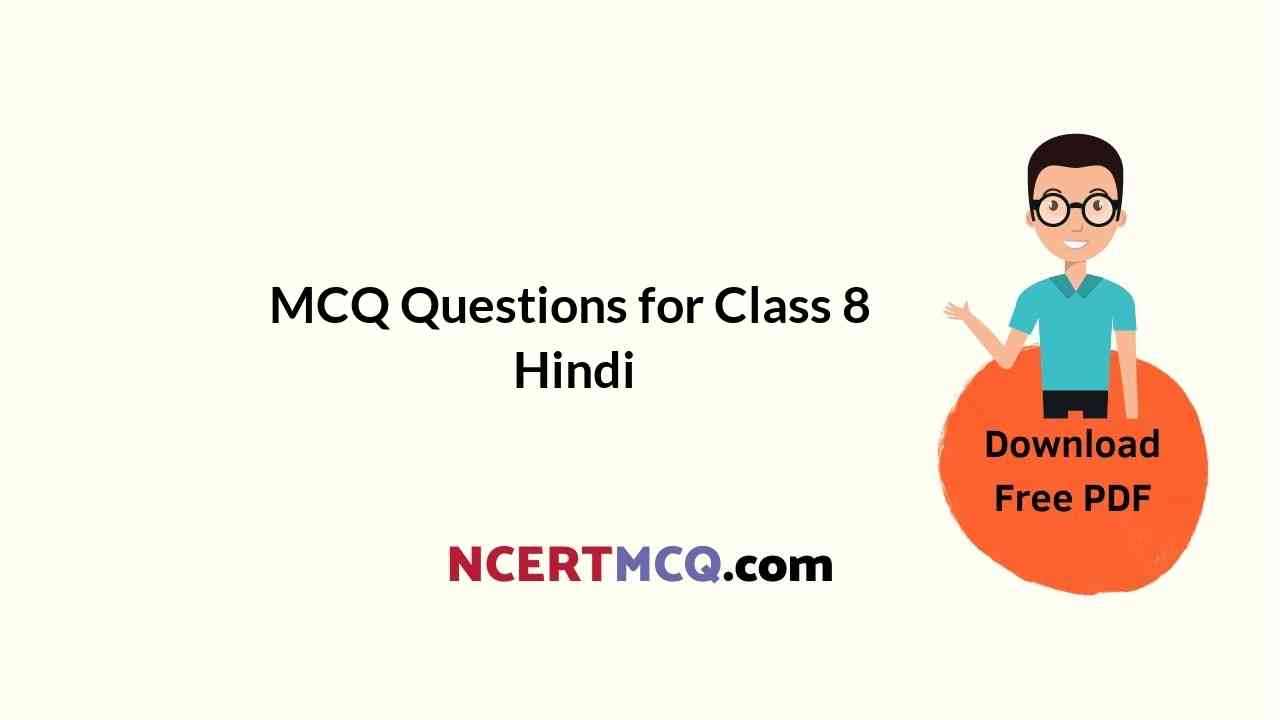
MCQ Questions for Class 8 Hindi भारत की खोज
Check the below NCERT MCQ Questions for Class 8 Hindi भारत की खोज with Answers Pdf free download. MCQ Questions for Class 8 Hindi with Answers were prepared based on the latest exam pattern. We have provided भारत की खोज Class 8 Hindi MCQs Questions with Answers to help students understand the concept very well.
Students can also read NCERT Solutions for Class 8 Hindi भारत की खोज Questions and Answers at LearnInsta. Here all questions are solved with a detailed explanation, It will help to score more marks in your examinations.
भारत की खोज Class 8 MCQs Questions with Answers
Question 1.
‘अहमदनगर का किला’ पाठ कब व किसके द्वारा लिखा गया।
(a) 14 अप्रैल 1914 में जवाहरलाल नेहरू जी द्वारा
(b) 13 अप्रैल 1944 में जवाहरलाल नेहरू जी द्वारा
(c) 13 अप्रैल 1944 में महात्मा गांधी द्वारा
(d) 14 अप्रैल 1933 सरदार बल्लभ भाई पटेल द्वारा
Answer
Answer: (b) 13 अप्रैल 1944 में जवाहरलाल नेहरू जी द्वारा
Question 2.
नेहरू जी ने जीवन में कितनी बार जेल की यात्रा की थी?
(a) आठ बार
(b) दो बार
(c) नौवीं बार
(d) पाँचवी बार
Answer
Answer: (c) नौवीं बार
Question 3.
नेहरू जी ने जेल में कैदी के रूप में कलम क्यों उठाई?
(a) पत्रकारिता के लिए
(b) भारतीय जनमानस में राष्ट्र प्रेम भरने के लिए
(c) इतिहास लिखने के लिए
(d) राष्ट्र का गान लिखने के लिए
Answer
Answer: (b) भारतीय जनमानस में राष्ट्र प्रेम भरने के लिए
Question 4.
मनुष्य का अतीत मनुष्य को किस प्रकार से प्रभावित करता है?
(a) अच्छे रूप में
(b) बुरे रूप में
(c) अच्छे और बुरे दोनों रूप में
(d) उपर्युक्त सभी
Answer
Answer: (c) अच्छे और बुरे दोनों रूप में
Question 5.
भारतीय विरासत की क्या विशेषता थी?
(a) आर्थिक संपन्नता को बढ़ाना
(b) विश्व-बंधुत्व का संदेश
(c) अलग-अलग रहने की प्रथा
(d) आत्म-निर्भरता
Answer
Answer: (b) विश्व-बंधुत्व का संदेश
Question 6.
मोहजोदड़ो की सभ्यता कितने वर्ष पुरानी है?
(a) 3000 वर्ष
(b) 5000 वर्ष
(c) 6000 वर्ष
(d) 4000 वर्ष
Answer
Answer: (b) 5000 वर्ष
Question 7.
सिंधु नदी का दूसरा नाम है?
(a) इंडस
(b) इंडिया
(c) इंदु
(d) इंद्रनील
Answer
Answer: (a) इंडस
Question 8.
एशिया की शक्ति कम होने पर कौन-सा द्वीप आगे बढ़ा?
(a) यूरोप
(b) संयुक्त राज्य अमेरिका
(c) इंग्लैंड
(d) इंडोनेशिया
Answer
Answer: (a) यूरोप
Question 9.
भारत का कौन-सा वर्ग इस समय बदलाव की कामना करता था?
(a) निम्न वर्ग
(b) मध्यम वर्ग
(c) उच्च वर्ग
(d) शासक वर्ग
Answer
Answer: (b) मध्यम वर्ग
Question 10.
भारत कितने वर्षों से अंग्रेज़ों के अत्याचार झेल रहा था?
(a) सौ वर्षों से
(b) दो सौ वर्षों से
(c) चार सौ वर्षों से
(d) पाँच सौ वर्षों से
Answer
Answer: (a) सौ वर्षों से
Question 11.
भारत का नाम किसके नाम पर पड़ा?
(a) राजा भारत
(b) राजा भरत
(c) भरतमुनि
(d) भारद्वाज
Answer
Answer: (b) राजा भरत
Question 12.
तक्षशिला के अवशेष कितने प्राचीन थे?
(a) दो हज़ार वर्ष पूर्व
(b) तीन हजार वर्ष पूर्व
(c) चार हजार वर्ष पूर्व
(d) पाँच हजार वर्ष पूर्व
Answer
Answer: (a) दो हज़ार वर्ष पूर्व
Question 13.
भारतीयों की जीवन शैली कैसी थी?
(a) खुशहाल
(b) अभावों व असुरक्षा से ग्रस्त
(c) सामान्य
(d) उच्च कोटि की
Answer
Answer: (b) अभावों व असुरक्षा से ग्रस्त
Question 14.
भारतीय अतीत का आधार क्या है?
(a) मोहनजोदड़ो
(b) गंगा-नदी
(c) सिंधुघाटी की सभ्यता
(d) तक्षशिला
Answer
Answer: (c) सिंधुघाटी की सभ्यता
Question 15.
सिंधु घाटी सभ्यता कितनी प्राचीन है?
(a) दो हज़ार वर्ष पूर्व
(b) तीन हजार वर्ष पूर्व
(c) पाँच हजार वर्ष पूर्व
(d) छह-सात हज़ार वर्ष पूर्व
Answer
Answer: (d) छह-सात हज़ार वर्ष पूर्व
Question 16.
आर्यों की मुख्य जीविका क्या थी?
(a) पशुपालन
(b) कृषि
(c) व्यापार
(d) उनमें कोई नहीं
Answer
Answer: (b) कृषि
Question 17.
सिंधु घाटी से पहले का इतिहास किसे माना जाता था?
(a) प्राचीन ग्रंथ
(b) अभिलेख
(c) वेद
(d) पुराण
Answer
Answer: (c) वेद
Question 18.
ऋगवेद की रचना कितने साल पुरानी है?
(a) 1500 ईसा पूर्व
(b) 2000 वर्ष पूर्व
(c) 2500 वर्ष पूर्व
(d) 3500 ईसा पूर्व
Answer
Answer: (a) 1500 ईसा पूर्व
Question 19.
किस वेद की उत्पत्ति सबसे पहले हुई थी?
(a) सामवेद
(b) अथर्ववेद
(c) रामायण
(d) ऋगवेद
Answer
Answer: (d) ऋगवेद
Question 20.
उपनिषदों की उत्पत्ति कब हुई थी?
(a) ई. पू. 500
(b) ई. पू. 800
(c) ई. पू. 1000
(d) ई. पू. 1200
Answer
Answer: (b) ई. पू. 800
Question 21.
भारतीय आर्य किस व्यवस्था में विश्वास करते थे।
(a) जातिवाद
(b) परिवारवाद
(c) व्यक्तिवाद
(d) अलगावाद
Answer
Answer: (c) व्यक्तिवाद
Question 22.
भौतिक साहित्य की जानकारी के स्रोत क्या हैं?
(a) शिलालेख
(b) बड़े-बड़े प्राचीन ग्रंथ
(c) भोजपत्र व ताड़पत्र
(d) पेड़ों के वृंत ने
Answer
Answer: (c) भोजपत्र व ताड़पत्र
Question 23.
‘अर्थशास्त्र’ की रचना कब हुई थी?
(a) ई.पू. पाँचवी शताब्दी
(b) ई.पू. आठवीं शताब्दी
(c) ई.पू. चौथी शताब्दी
(d) ई.पू. सातवीं शताब्दी
Answer
Answer: (c) ई.पू. चौथी शताब्दी
Question 24.
भारत के दो प्रमुख महाकाव्यों का नाम बताइए।
(a) रामायण व गीता
(b) गीता व महाभारत
(c) रामायण व महाभारत
(d) रामायण व पुराण
Answer
Answer: (c) रामायण व महाभारत
Question 25.
इनमें से प्राचीन काल का ग्रंथ कौन-सा है?
(a) वेद व्यास द्वारा रचित महाभारत
(b) वाल्मीकि द्वारा रचित रामायण
(c) तुलसीदास द्वारा रचित रामायण
(d) कल्हण द्वारा रचित राजतरंगिनी
Answer
Answer: (d) कल्हण द्वारा रचित राजतरंगिनी
Question 26.
प्राचीन समय में भारत की राजधानी थी।
(a) लखनऊ
(b) कानपुर
(c) जम्मू
(d) इंद्रप्रस्थ
Answer
Answer: (d) इंद्रप्रस्थ
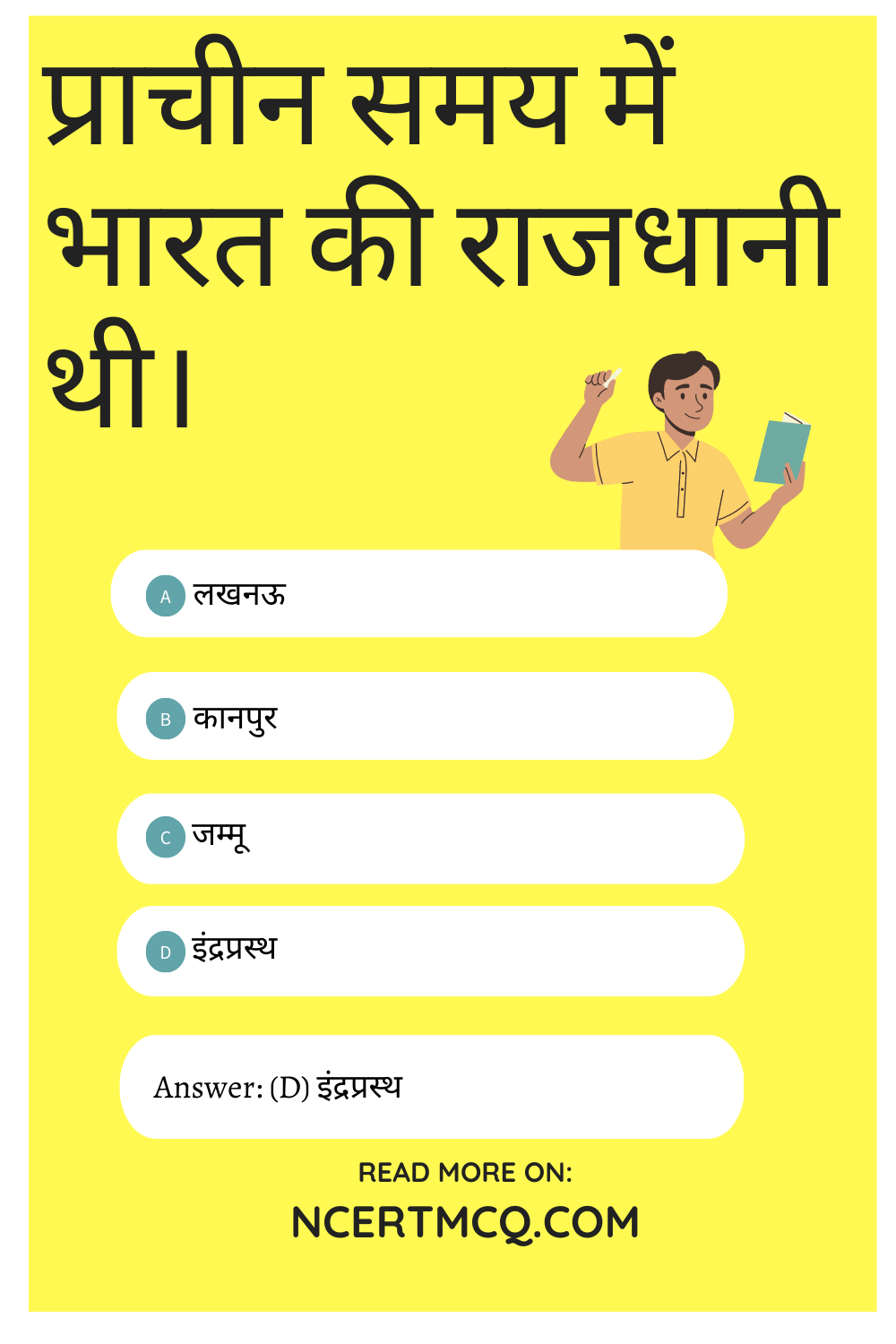
Question 27.
इनमें महाभारत का मुख्य भाग कौन-सा है?
(a) पुराण
(b) गीता
(c) रामायण
(d) भगवद्गीता
Answer
Answer: (d) भगवद्गीता
Question 28.
भगवद्गीता ने किसके व्यक्तित्व को उभारा है?
(a) शिव
(b) राम
(c) श्रीकृष्ण
(d) विष्णु
Answer
Answer: (c) श्रीकृष्ण
Question 29.
प्राचीन काल में किसान अपने कृषि उत्पादन का कितना हिस्सा कर के रूप में राजा को देते थे?
(a) एक चौथाई
(b) आधा
(c) दशांश
(d) छठा
Answer
Answer: (d) छठा
Question 30.
सबसे पहले प्राचीन काल में किस लिपि का निर्माण हुआ?
(a) देवनागरी
(b) ब्राह्मी लिपि
(c) रोमन लिपि
(d) गुरुमुखी
Answer
Answer: (b) ब्राह्मी लिपि
Question 31.
संस्कृत भाषा के व्याकरण की रचना किसने की थी?
(a) तुलसीदास
(b) देवनागरी
(c) पाणिनी
(d) वाल्मीकि
Answer
Answer: (c) पाणिनी
Question 32.
‘औषधि’ विज्ञान पर किसकी पुस्तकें लोकप्रिय थीं?
(a) सुश्रुत
(b) पाणिनी
(c) चरक
(d) धन्वंतरि
Answer
Answer: (d) धन्वंतरि
Question 33.
प्राचीन काल के प्रमुख शल्य चिकित्सक थे?
(a) सुश्रुत
(b) पाणिनी
(c) चरक
(d) धनवंतरि
Answer
Answer: (a) सुश्रुत
Question 34.
भारत के शिक्षा केंद्र कौन से थे?
(a) तक्षशिला व काशी
(b) बनारस व तक्षशिला
(c) इलाहाबाद व बनारस
(d) इंद्रप्रस्थ व तक्षशिला
Answer
Answer: (b) बनारस व तक्षशिला
Question 35.
बौद्ध और जैन धर्म किस धर्म से अलग होकर बने?
(a) हिंदू धर्म
(b) वैश्य धर्म
(c) वैदिक धर्म
(d) इसाई धर्म
Answer
Answer: (c) वैदिक धर्म
Question 36.
बुद्ध ने घृणा का अंत किस प्रकार करने को कहा?
(a) घृणा से
(b) प्रेम से
(c) लड़ाई से
(d) विरोध से
Answer
Answer: (b) प्रेम से
Question 37.
चंद्रगुप्त मौर्य कहाँ के रहने वाले थे?
(a) पाटलीपुत्र
(b) इंद्रप्रस्थ
(c) तक्षशिला
(d) मगध
Answer
Answer: (d) मगध
Question 38.
चाणक्य था?
(a) चंद्रगुप्त का मंत्री
(b) चंद्रगुप्त का सलाहकार
(c) चंद्रगुप्त का मित्र
(d) उपर्युक्त सभी
Answer
Answer: (d) उपर्युक्त सभी
Question 39.
चाणक्य का दूसरा नाम था?
(a) चरक
(b) सुश्रुत
(c) कौटिल्य
(d) अशोक
Answer
Answer: (c) कौटिल्य
Question 40.
मौर्य साम्राज्य के पतन के बाद कौन से शासक आए?
(a) कुषाण
(b) शुंगवंश
(c) हूण
(d) शक
Answer
Answer: (b) शुंगवंश
Question 41.
कुषाणों का लोकप्रिय राजा कौन था?
(a) अशोक
(b) जरथुष्ट्र
(c) कनिष्क
(d) नागार्जुन
Answer
Answer: (c) कनिष्क
Question 42.
चंद्रगुप्त ने किस साम्राज्य की नींव रखी?
(a) गुप्त साम्राज्य
(b) मौर्य साम्राज्य
(c) कुषाण साम्राज्य
(d) अन्य
Answer
Answer: (a) गुप्त साम्राज्य
Question 43.
हर्षवर्धन ने अपनी राजधानी कहाँ बनाया?
(a) कर्नाटक
(b) जयपुर
(c) इंद्रप्रस्थ
(d) उज्जयिनी
Answer
Answer: (d) उज्जयिनी
Question 44.
दक्षिणी भारत की लोकप्रियता का कारण था
(a) अपनी अच्छी जलवायु
(b) दस्तकारी व समुद्री व्यापार
(c) अपनी सुदृढ़ शासन सत्ता
(d) आपसी एकता
Answer
Answer: (b) दस्तकारी व समुद्री व्यापार
Question 45.
जब अंग्रेज़ भारत आए उस समय देश की स्थिति क्या थी?
(a) संपन्न
(b) धार्मिकता से ग्रस्त
(c) जातीयता से ग्रस्त
(d) अवनति की ओर
Answer
Answer: (d) अवनति की ओर
Question 46.
भारतीय सभ्यता के विकास का क्या कारण था?
(a) स्थिरता
(b) सुरक्षा
(c) संपन्नता
(d) कठोर शासक
Answer
Answer: (a) स्थिरता
Question 47.
भारतीय रंगमंच का उद्गम कहाँ हुआ?
(a) सामवेद में
(b) यजुर्वेद में
(c) ऋगवेद में
(d) इनमें से कोई नहीं
Answer
Answer: (c) ऋगवेद में
Question 48.
कालिदास की प्रमुख रचना कौन-सी थी?
(a) मेघदूत
(b) शकुंतला
(c) मृच्छकटिकम्
(d) मुद्राराक्षस
Answer
Answer: (b) शकुंतला
Question 49.
प्राचीन नाटकों की भाषा कैसी थी?
(a) हिंदी
(b) संस्कृत
(c) उर्दू
(d) परसियन
Answer
Answer: (b) संस्कृत
Question 50.
संस्कृत भाषा को नियमों में किसने बाँधा? .
(a) पाणिनी
(b) भास
(c) कालिदास
(d) इनमें से कोई नहीं
Answer
Answer: (a) पाणिनी
Question 51.
संस्कृत को व्याकरणिक नियमों में कब बाँधा गया?
(a) 2000 वर्ष पूर्व
(b) 3000 वर्ष पूर्व
(c) 2600 वर्ष पूर्व
(d) 1600 वर्ष पूर्व
Answer
Answer: (c) 2600 वर्ष पूर्व
Question 52.
भारत का व्यापार व धर्म का प्रचार-प्रसार विदेशों में कैसे हुआ?
(a) अपना उपनिवेश कायम करके
(b) शासन सत्ता बढ़ाकर
(c) युद्ध करके
(d) इनमें से कोई नहीं
Answer
Answer: (a) अपना उपनिवेश कायम करके
Question 53.
जावा में किस भारतीय कला को विशेष प्रसिद्धि मिली?
(a) नृत्य
(b) साहित्य
(c) भवन-निर्माण
(d) धर्म
Answer
Answer: (a) नृत्य
Question 54.
फिलीपाइन देश की लेखन कला किस देश की देन है?
(a) भारत
(b) श्रीलंका
(c) अफगानिस्तान
(d) मध्य एशिया
Answer
Answer: (a) भारत
Question 55.
गुप्तकाल में सबसे अधिक विकास किस दिशा में हुआ?
(a) शासनसत्ता
(b) वास्तुकला
(c) राजनीति
(d) धर्म
Answer
Answer: (b) वास्तुकला
Question 56.
गणित शास्त्र की शुरुआत भारत में कब हुई?
(a) प्राचीन काल
(b) वैदिक काल
(c) आदि काल
(d) मध्य काल
Answer
Answer: (c) आदि काल
Question 57.
भारत के पतन के क्या कारण थे?
(a) बूढ़ा होना
(b) आपस में विखंडित होना
(c) एक के बाद एक विदेशी शासक का भारत पर शासन करना और राजनीति का टूटना
(d) योग्य शासक का आभाव
Answer
Answer: (c) एक के बाद एक विदेशी शासक का भारत पर शासन करना और राजनीति का टूटना
Question 58.
बाबर कौन था?
(a) मुगल शासन का संस्थापक
(b) मुगल शासन का सेनापति
(c) इस्लाम धर्म का संस्थापक
(d) एक विदेशी आक्रमणकारी
Answer
Answer: (a) मुगल शासन का संस्थापक
Question 59.
बाबर ने भारतीय सत्ता की नींव कब रखी?
(a) 1770
(b) 1530
(c) 1526 में
(d) 1600
Answer
Answer: (c) 1526 में
Question 60.
अकबर ने किस धर्म को चलाया?
(a) दीन.ए.एलाही
(b) मुस्लिम धर्म
(c) इसाई धर्म
(d) फ़ारसी धर्म
Answer
Answer: (a) दीन.ए.एलाही
Question 61.
महमूद गज़नवी ने भारत पर आक्रमण की शुरुआत कब की?
(a) 1000 ई. में
(b) 1100 ई. में
(c) 1200 ई. में
(d) 800 ई. में
Answer
Answer: (a) 1000 ई. में
Question 62.
मुगल काल की वास्तुकला का सुंदर नमूना कौन-सा है?
(a) फतेहपुर सीकरी
(b) कुतुबमीनार
(c) ताजमहल
(d) लालकिला
Answer
Answer: (c) ताजमहल
Question 63.
‘पद्मावत’ ग्रंथ की रचना किसने की?
(a) रहीम
(b) जायसी
(c) तुलसी
(d) कबीर
Answer
Answer: (b) जायसी
Question 64.
मराठों के सेना नायक कौन थे?
(a) छत्रपति शिवाजी
(b) रणजीत सिंह
(c) टीपू सुल्तान
(d) दारा
Answer
Answer: (a) छत्रपति शिवाजी
Question 65.
मुगलकाल के पतन के बाद शक्तिशाली शासक के रूप में कौन उभरे?
(a) टीपू सुल्तान
(b) हैदर अली
(c) मराठे
(d) अंग्रेज़
Answer
Answer: (c) मराठे
Question 66.
नादिरशाह कहाँ का शासक था?
(a) ईरान
(b) इराक
(c) अफगानिस्तान
(d) चीन
Answer
Answer: (a) ईरान
Question 67.
जयसिंह ने किस राज्य का निर्माण कराया?
(a) आगरा
(b) जयपुर
(c) बनारस
(d) इलाहाबाद
Answer
Answer: (b) जयपुर
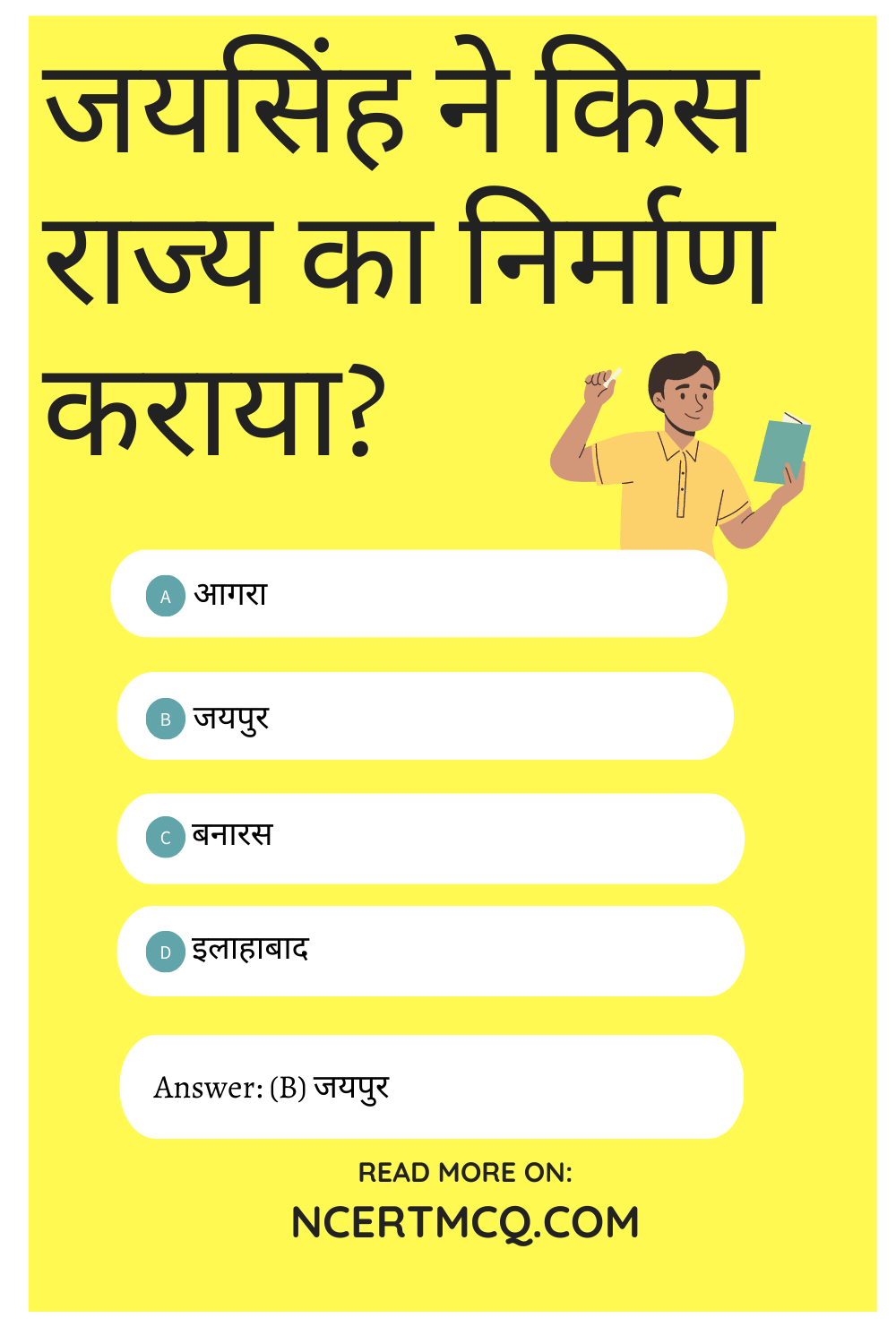
Question 68.
भारत में ईस्ट इंडिया की स्थापना कब हुई?
(a) 1700
(b) 1800
(c) 1600
(d) 1500
Answer
Answer: (c) 1600
Question 69.
अंग्रेजों के समय में भारत में कौन से दो मुख्य विभाग थे?
(a) धर्म व राजनीति
(b) माल गुजारी व पुलिस
(c) भारतीय व अंग्रेजों के शासकीय विभाग
(d) गाँवों व शहरों के सत्ता के अलग-अलग विभाग
Answer
Answer: (b) माल गुजारी व पुलिस
Question 70.
प्रत्येक जिले में प्रमुख पद क्या घोषित हुआ? ।
(a) सरपंच
(b) कलेक्टर
(c) राजस्व पदाधिकारी
(d) पुलिस अधिकारी
Answer
Answer: (b) कलेक्टर
Question 71.
इस समय बंगाल कितने वर्षों से अंग्रेज़ों के चुंगल में था?
(a) 40 वर्ष
(b) 50 वर्ष
(b) 60 वर्ष
(d) 25 वर्ष
Answer
Answer: (b) 50 वर्ष
Question 72.
राजा राममोहन राय ने किस प्रथा पर रोक लगाई ?
(a) बाल विवाह
(b) विधवा विवाह
(c) सती प्रथा
(d) परदा प्रथा
Answer
Answer: (c) सती प्रथा
Question 73.
भारतीय द्वारा संपादित पहला समाचार-पत्र कब प्रकाशित हुआ?
(a) 1800 ई. में
(b) 1818 ई. में
(c) 1856 ई. में
(d) 1885 ई. में
Answer
Answer: (b) 1818 ई. में
Question 74.
प्रथम स्वतंत्रता संग्राम की शुरुआत कब हुई थी?
(a) 1805 ई. में
(b) 1826 ई. में
(c) 1850 ई. में
(d) 1857 ई. में
Answer
Answer: (d) 1857 ई. में
Question 75.
‘राजा राममोहन राय’ ने किस समाज की स्थापना की थी?
(a) वृद्ध समाज
(b) ब्रह्म समाज
(c) स्त्री समाज
(d) बंगाल समाज
Answer
Answer: (b) ब्रह्म समाज
Question 76.
रामकृष्ण मिशन के संस्थापक कौन थे?
(a) स्वामी विवेकानंद
(b) रवींद्र नाथ टैगोर
(c) स्वामी दयानंद सरस्वती
(d) राजा राम मोहन राय
Answer
Answer: (a) स्वामी विवेकानंद
Question 77.
‘मुस्लिम लीग’ की स्थापना किसने की थी?
(a) अबुल कलाम आजाद
(b) सर सैयद खाँ
(c) अलीगढ़ कॉलेज के मुसलमान बुद्धिजीवी
(d) आम मुस्लिम वर्ग
Answer
Answer: (c) अलीगढ़ कॉलेज के मुसलमान बुद्धिजीवी
Question 78.
भारत में आज़ादी के लिए किन दो गुटों ने जन्म लिया?
(a) उग्र और नरम
(b) नरम दल और गरम दल
(c) तीव्र और भेद
(d) मुख्य और गौण
Answer
Answer: (b) नरम दल और गरम दल
Question 79.
गांधी जी की कार्य पदधति का रूप क्या था?
(a) हिंसात्मक
(b) अहिंसात्मक
(c) विरोध
(d) बदला
Answer
Answer: (b) अहिंसात्मक
Question 80.
भारत के विभाजन में किस नेता का योगदान रहा?
(a) मिस्टर जिन्ना
(b) अबुल कलाम आजाद
(c) गांधी
(d) जवाहर लाल नेहरू
Answer
Answer: (a) मिस्टर जिन्ना
Question 81.
कांग्रेस किस सिद्धांत पर अडिग रही?
(a) राष्ट्रीय एकता
(b) लोकतंत्र
(c) राष्ट्रीय एकता और लोकतंत्र
(d) अन्य
Answer
Answer: (c) राष्ट्रीय एकता और लोकतंत्र
Question 82.
भारत में राजनैतिक तनाव कब सबसे अधिक था?
(a) सन् 1950 में
(b) सन् 1947 में
(c) सन् 1942 में
(d) सन् 1947 में
Answer
Answer: (c) सन् 1942 में
Question 83.
सन् 1942 का समय किस दौर का था?
(a) प्रथम विश्व युद्ध का
(b) द्वितीय विश्व युद्ध का
(c) राष्ट्रीयकरण का
(d) भारत-पाकिस्तान के विभाजन का
Answer
Answer: (b) द्वितीय विश्व युद्ध का
Question 84.
भारत छोड़ो आंदोलन की शुरुआत कब हुई थी?
(a) सन् 1942 ई. में
(b) सन् 1940 में
(c) सन् 1950 ई. में
(d) 1945 ई. में
Answer
Answer: (a) सन् 1942 ई. में
Question 85.
जनता अब सरकार के विरुद्ध कैसा प्रदर्शन कर रही थी?
(a) शांतिपूर्ण
(b) हिंसात्मक
(c) शांतिपूर्ण व हिंसात्मक दोनों
(d) इनमें से कोई नहीं
Answer
Answer: (c) शांतिपूर्ण व हिंसात्मक दोनों
Question 86.
इस विद्रोह में पुलिस और सेना की गोलाबारी से मारे गए लोगों की संख्या लगभग कितनी थी?
(a) 820
(b) 1120
(c) 1020
(d) 1028
Answer
Answer: (b) 1120
Question 87.
भारत में भयंकर अकाल कब पड़ा?
(a) 1942 में
(b) 1943 में
(c) 1944 में
(d) 1945 में
Answer
Answer: (c) 1944 में
We hope the given NCERT MCQ Questions for Class 8 Hindi भारत की खोज with Answers Pdf free download will help you. If you have any queries regarding CBSE Class 8 Hindi भारत की खोज MCQs Multiple Choice Questions with Answers, drop a comment below and we will get back to you soon.
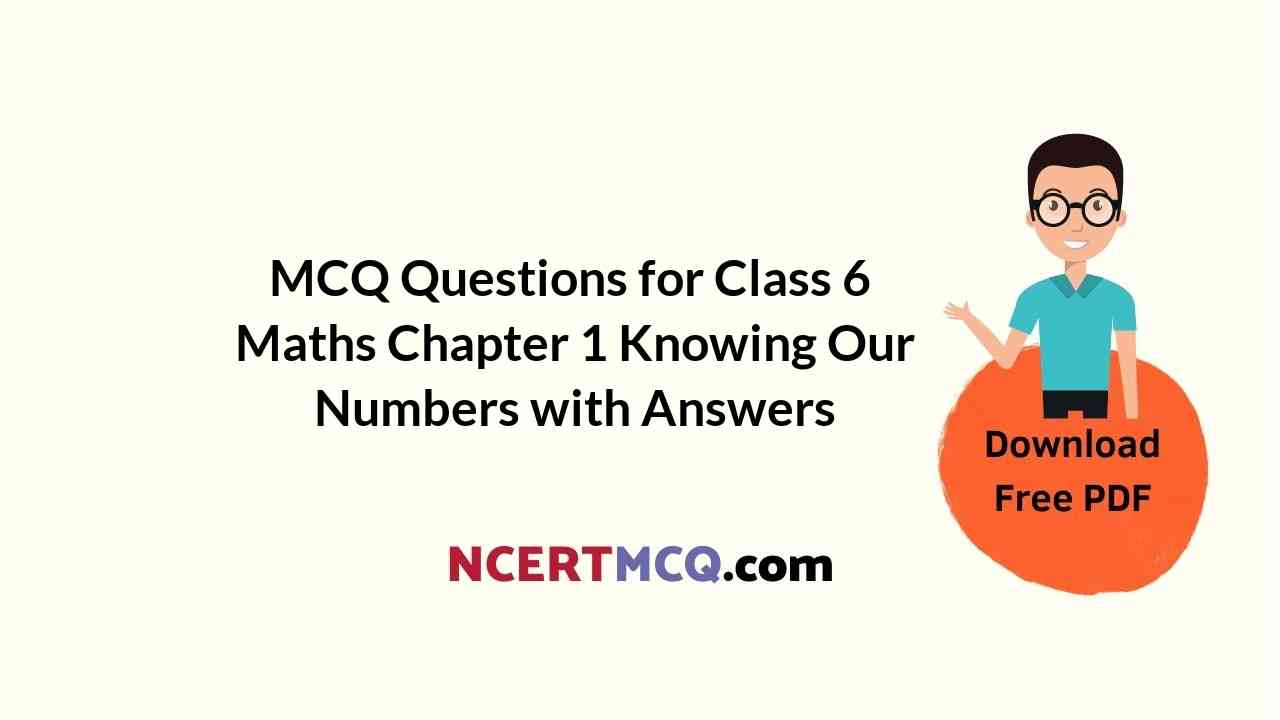
MCQ Questions for Class 6 Maths Chapter 1 Knowing Our Numbers with Answers
Check the below NCERT MCQ Questions for Class 6 Maths Chapter 1 Knowing Our Numbers with Answers Pdf free download. MCQ Questions for Class 6 Maths with Answers were prepared based on the latest exam pattern. We have provided Knowing Our Numbers Class 6 Maths MCQs Questions with Answers to help students understand the concept very well.
Students can also refer to NCERT Solutions for Class 6 Maths Chapter 2 Knowing Our Numbers for better exam preparation and score more marks.
Knowing Our Numbers Class 6 MCQs Questions with Answers
Class 6 Maths Chapter 1 MCQ Question 1.
The greatest of the numbers
123, 27, 650, 2342, 40000 is
(a) 40000
(b) 2342
(c) 27
(d) 650.
Answer
Answer: (a)
MCQ Questions For Class 6 Maths Chapter 1 Question 2.
The greatest of the numbers
1000,10000,10,1000000,100000 is
(a) 1000000
(b) 100000
(c) 10000
(d) 1000.
Answer
Answer: (a)
MCQ On Knowing Our Numbers Class 6 Question 3.
The smallest of the numbers
1000,50000,111,3222,225 is
(a) 111
(b) 225
(c) 1000
(d) 3222.
Answer
Answer: (a)
Knowing Our Numbers Class 6 MCQ Question 4.
The smallest of the numbers
2325,2352,2235,2253,2523,2532 is
(a) 2235
(b) 2253
(c) 2325
(d) 2532.
Answer
Answer: (a)
Class 6 Maths MCQ Chapter 1 Question 5.
Using the digits 1, 2, 3, 4 without repetition, the greatest 4-digit number that can be made is
(a) 4321
(b) 4312
(c) 4213
(d) 4231.
Answer
Answer: (a)
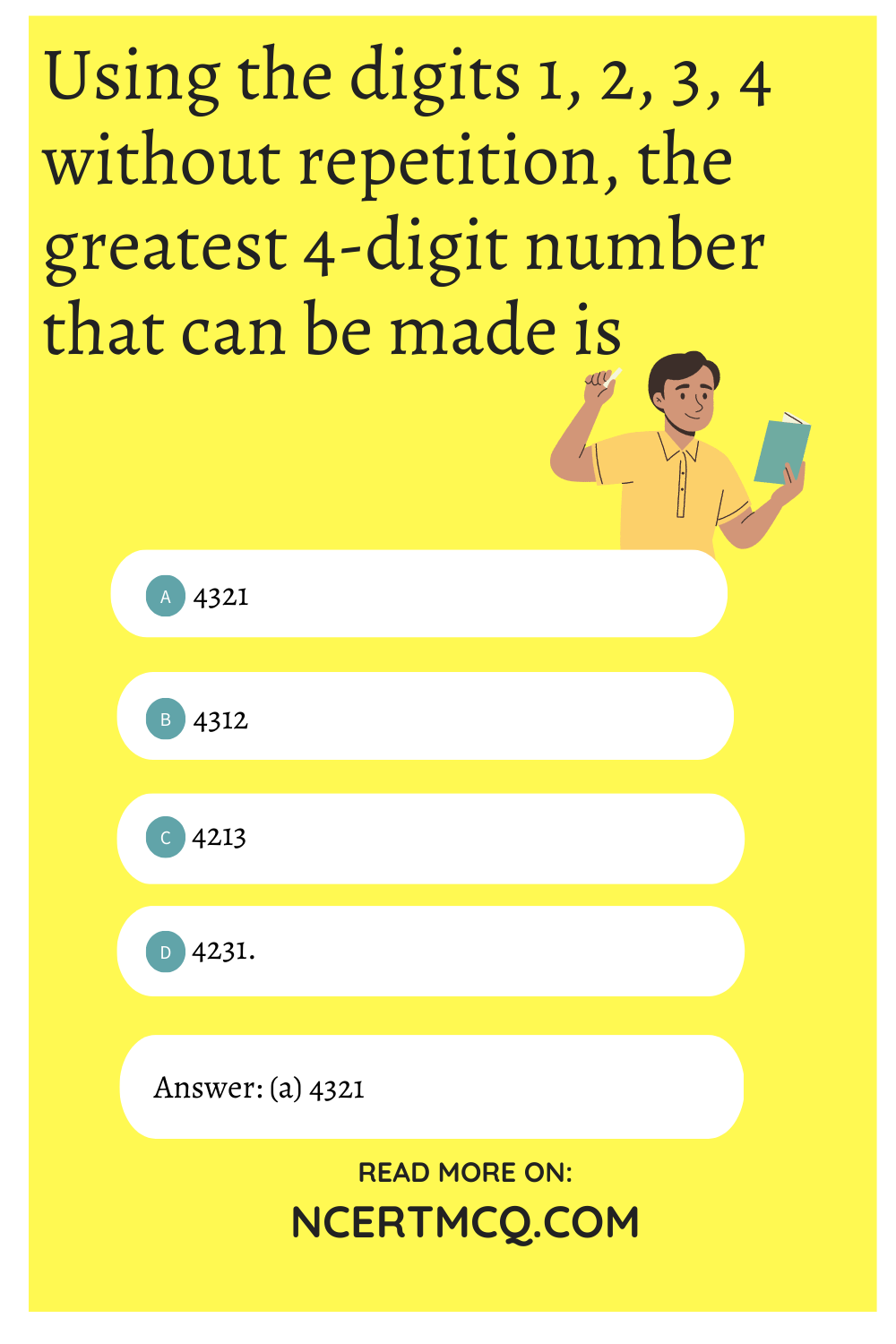
MCQ Class 6 Maths Chapter 1 Question 6.
Using the digits 1, 5, 7, 2 without repetition, the greatest 4-digit number that can be made is
(a) 7521
(b) 7512
(c) 7215
(d) 7251.
Answer
Answer: (a)
MCQ For Class 6 Maths Chapter 1 Question 7.
Using the digits 3, 5, 7, 0 without repetition the greatest 4-digit number that can be made is
(a) 7530
(b) 7503
(c) 7350
(d) 7305.
Answer
Answer: (a)
Knowing Our Numbers MCQ Question 8.
The smallest 4-digit number that can be made using the digits 1,8,5,3 without repetition is
(a) 1583
(b) 1538
(c) 1385
(d) 1358.
Answer
Answer: (d)
Class 6 Maths Chapter 1 MCQ Test Question 9.
The smallest 4-digit number that can be made using the digits 5,3,6,4 without repetition is
(a) 3546
(b) 3564
(c) 3456
(d) 3465.
Answer
Answer: (c)
MCQ Maths Class 6 Chapter 1 Question 10.
The smallest 4-digit number that can be made using the digits 6, 5, 0, 4 without repetition is
(a) 4560
(b) 4056
(c) 4065
(d) 4506.
Answer
Answer: (b)
MCQ Questions For Class 6 Maths Ncert Chapter 1 Question 11.
Make the greatest 4-digit number by using any one digit of 2. 6. 5 twice.
(a) 6652
(b) 6625
(c) 6256
(d) 6265.
Answer
Answer: (a)
Class 6 Math Chapter 1 MCQ Question 12.
Make the greatest 4-digit number by using any one digit of 0, 3, 6 twice.
(a) 6630
(b) 6603
(c) 6360
(d) 6306.
Answer
Answer: (a)
MCQ Questions Class 6 Maths Chapter 1 Question 13.
Make the smallest 4-digit number by using any one digit of 4,3,2 twice.
(a) 2234
(b) 2243
(c) 2432
(d) 2324.
Answer
Answer: (a)
Class 6 Maths Chapter 1 MCQ Questions Question 14.
Make the smallest 4-digit number by using any one digit of 7, 0, 6 twice.
(a) 6007
(b) 6070
(c) 6700
(d) None of these.
Answer
Answer: (a)
Class 6th Maths Chapter 1 MCQ Question 15.
Take two digits, say 1 and 2. Make the greatest 4-digit number using both the digits equal number of times.
(a) 1122
(b) 2112
(c) 2121
(d) 2211.
Answer
Answer: (d)
Class 6 Maths Ch 1 MCQ Question 16.
Take two digits, say 3 and 4. Make the smallest 4-digit number using both the digits equal number of times.
(a) 3344
(b) 4433
(c) 4343
(d) 4334.
Answer
Answer: (a)
Question 17.
Take two digits 0 and 1. Make the greatest 4-digit number using both the digits equal number of times.
(a) 1100
(b) 1001
(c) 1010
(d) None of these.
Answer
Answer: (a)
Question 18.
Take two digits, 0 and 1. Make the smallest 4-digit number using both the digits equal number of times.
(a) 1001
(b) 1010
(c) 1100
(d) None of these.
Answer
Answer: (a)
Question 19.
Make the greatest 4-digit number using any four different digits with the condition that 5 is at ones place.
(a) 9875
(b) 9857
(c) 9758
(d) 9785.
Answer
Answer: (a)
Question 20.
Make the smallest four-digit number using any four different digits such that 5 is at ones place,
(a) 1025
(b) 1205
(c) 1250
(d) None of these.
Answer
Answer: (a)
Question 21.
Arrange the following numbers in ascending
order: 132,2000,7500,525.
(а) 7500,2000,525,132
(b) 132,525,2000,7500
(c) 132,525,7500,2000
(d) 7500,2000,132,525.
Answer
Answer: (b)
Question 22.
Arrange the following numbers in descending
order: 4000,8500,50600,7235.
(а) 50600,8500,7235,4000
(b) 50600,8500,4000,7235
(c) 50600,7235,8500,4000
(d) 50600,7235,4000,8500.
Answer
Answer: (a)
Question 23.
The greatest 2-digit number is
(a) 98
(b) 99
(c) 79
(d) 89.
Answer
Answer: (b)
Question 24.
The smallest 2-digit number is
(a) 31
(b) 21
(c) 11
(d) 10.
Answer
Answer: (d)
Question 25.
The greatest 3-digit number is
(a) 991
(b) 997
(c) 999
(d) 998.
Answer
Answer: (c)
Question 26.
The smallest 3-digit number is
(a) 100
(b) 101
(c) 111
(d) none of these.
Answer
Answer: (a)
Question 27.
The greatest 4-digit number is
(a) 8888
(b) 6789
(c) 9876
(d) 9999.
Answer
Answer: (d)
Question 28.
The smallest 4-digit number is
(a) 1001
(b) 1000
(c) 1111
(d) 9999.
Answer
Answer: (b)
Question 29.
Which of the following numbers comes next to 999?
(a) 100
(b) 998
(c) 1000
(d) None of these.
Answer
Answer: (c)
Question 30.
Which of the following numbers comes just before 1000?
(a) 999
(b) 1001
(c) 990
(d) 909.
Answer
Answer: (a)
Question 31.
Which of the following numbers is equal to 1 lakh?
(a) 100000
(b) 10000
(c) 1000
(d) 100.
Answer
Answer: (a)
Question 32.
Which of the following numbers is equal to 1 crore ?
(a) 10000000
(b) 1000000
(c) 100000
(d) 10000.
Answer
Answer: (a)
Question 33.
1 million = how many lakh?
(a) 10
(b) 100
(c) 1000
(d) 10000.
Answer
Answer: (a)
Question 34.
1 crore = how many million?
(a) 10000
(b) 1000
(c) 100
(d) 10.
Answer
Answer: (d)
Question 35.
1 billion.= how many million?
(a) 10
(b) 100
(c) 1000
(d) 10000.
Answer
Answer: (c)
Question 36.
1 lakh = how many ten thousand?
(a) 1
(b) 10
(c) 100
(d) 1000.
Answer
Answer: (b)
Question 37.
1 million = how many hundred thousand?
(a) 10
(b) 100
(c) 1
(d) None of these.
Answer
Answer: (a)
Question 38.
1 crore = how many ten lakhs?
(a) 100
(b) 1
(c) 10
(d) None of these.
Answer
Answer: (c)
Question 39.
Insert comma suitably in 67810138 by using International System.
(a) 67,810,138
(b) 67,81,01,38
(c) 6,78,10,138
(d) 678,10,138.
Answer
Answer: (a)
Question 40.
1 centimetre =? millimetres
(a) 10
(b) 100
(c) 1000
(d) none of these.
Answer
Answer: (a)
Question 41.
1 metre =? centimetres
(a) 10
(b) 100
(c) 1000
(d) none of these.
Answer
Answer: (b)
Question 42.
1 metre =? millimetres
(a) 10
(b) 100
(c) 1000
(d) none of these.
Answer
Answer: (c)
Question 43.
1 Kilometre =? metres
(a) 1000
(b) 10
(c) 100
(d) none of these.
Answer
Answer: (a)
Question 44.
1 km = ? mm
(a) 10,00,000
(b) 1,00,000
(c) 10,000
(d) 1000.
Answer
Answer: (a)
Question 45.
49 to the nearest tens is
(a) 50
(b) 40
(c) 45
(d) 55.
Answer
Answer: (a)
Question 46.
123 to the nearest tens is
(a) 130
(b) 120
(c) 125
(d) 123.
Answer
Answer: (b)
Question 47.
Which of the following rounding off is correct?
(a) 841 → 800
(b) 286 → 200
(c) 9870 → 9800
(d) 87 → 80.
Answer
Answer: (a)
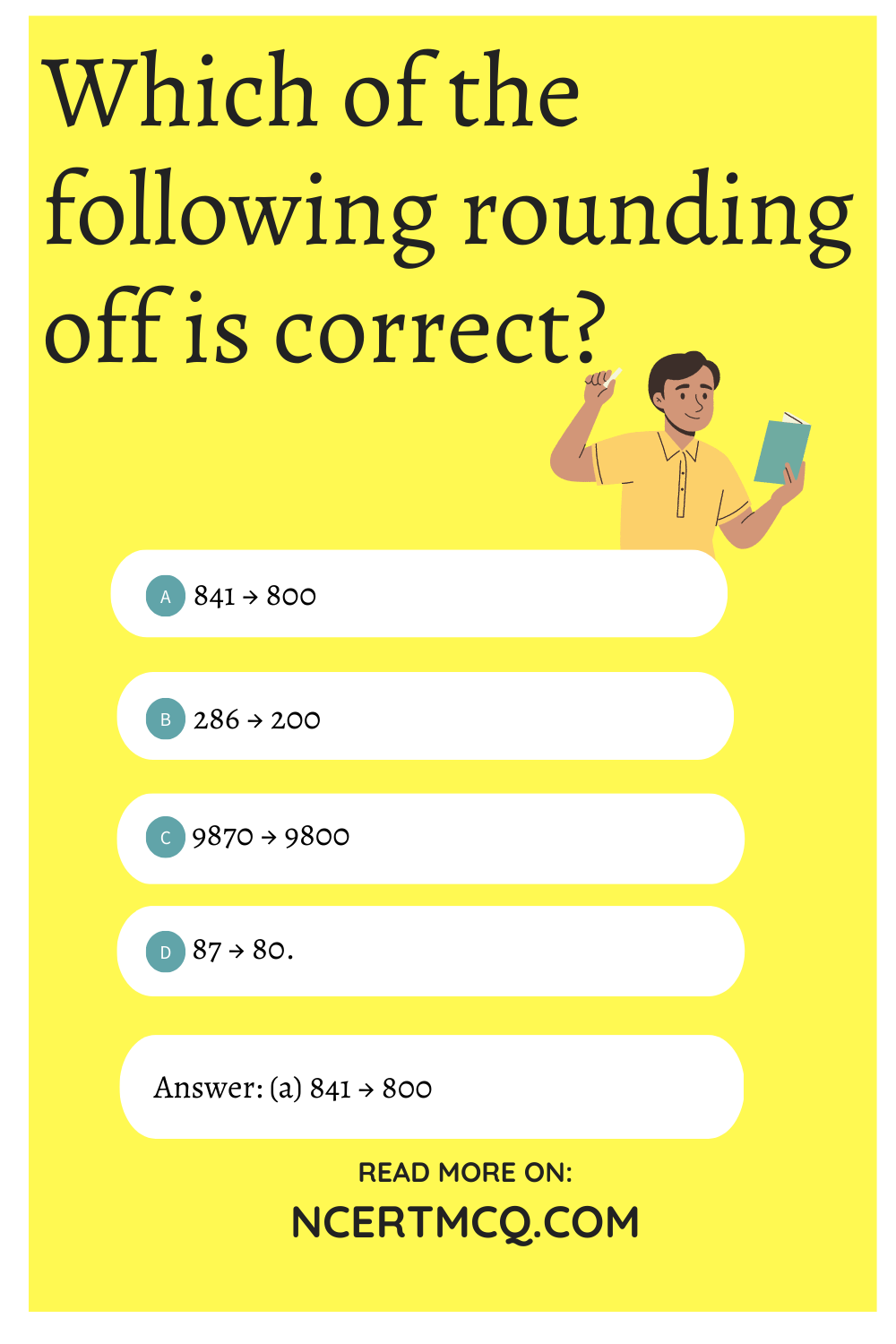
Question 48.
In Roman numerals L stands for
(a) 100
(b) 50
(c) 70
(d) 90.
Answer
Answer: (b)
Question 49.
In Roman numerals C stands for
(a) 10
(b) 100
(c) 1000
(d) 1.
Answer
Answer: (b)
Question 50.
In Raman numerals D stands for
(a) 100
(b) 1000
(c) 500
(d) 10.
Answer
Answer: (c)
Question 51.
In Raman numerals M stands for
(a) 1000
(b) 100
(c) 10
(d) none of these.
Answer
Answer: (a)
Question 52.
60 in Roman numerals is
(a) LX
(b) LXX
(c) LXXX
(d) XL.
Answer
Answer: (a)
Question 53.
80 in Roman numerals is
(a) LXXX
(b) LXX
(c) LX
(d) XXXL.
Answer
Answer: (a)
Question 54.
90 in Roman numerals is
(a) XL
(d) XC
(c) CX
(d) LX.
Answer
Answer: (b)
Question 55.
I made an expenditure of ₹ 2725 in November, 2009 and of ₹ 2275 in December, 2009. What is the total expenditure made by me in November, 2009 and December, 2009 together?
(a) ₹ 2000
(b) ₹ 3000
(c) ₹ 4000
(d) ₹ 5000.
Answer
Answer: (d)
Hint:
Total expenditure = 2725 + 2275 = 5000
Question 56.
The difference between the greatest number of 4-digit and the smallest number of 5-digit is
(a) 1
(b) 10
(c) 100
(d) 11.
Answer
Answer: (a)
Hint:
Difference = 10,000 – 9999 = 1
Question 57.
The monthly salary of Apala is ₹ 20975 and that of Meenu is ₹ 15875. The difference of their monthly salaries is
(a) ₹ 6000
(b) ₹ 4900
(c) ₹ 5000
(d) ₹ 5100.
Answer
Answer: (d)
Hint:
Difference = 20975 – 15875 = 5100
Question 58.
To stitch a trouser 1 m 25 cm cloth is required. Out of 10 m cloth, how many trousers can be stitched?
(a) 2
(b) 4
(c) 6
(d) 8.
Answer
Answer: (d)
Hint:
1 m 25 cm = 125 cm
10m = 1000cm
1000 ÷ 125 = 8
Question 59.
Manish multiplied 100 by 89 instead of multiplying by 79. How much was his answer greater than the correct answer?
(a) 100
(b) 1000
(c) 10000
(d) None of these.
Answer
Answer: (b)
Hint:
100 × 89 = 8900
100 × 79 = 7900
8900 – 7900 = 1000
Question 60.
Sangeeta types 25 pages per day. How many pages will she type in the month of November ?
(a) 900
(b) 800
(c) 700
(d) 750
Answer
Answer: (d)
Hint:
Number of days in
November, 2009 = 30
25 × 30 = 750
We hope the given NCERT MCQ Questions for Class 6 Maths Chapter 1 Knowing Our Numbers with Answers Pdf free download will help you. If you have any queries regarding Knowing Our Numbers CBSE Class 6 Maths MCQs Multiple Choice Questions with Answers, drop a comment below and we will get back to you soon.
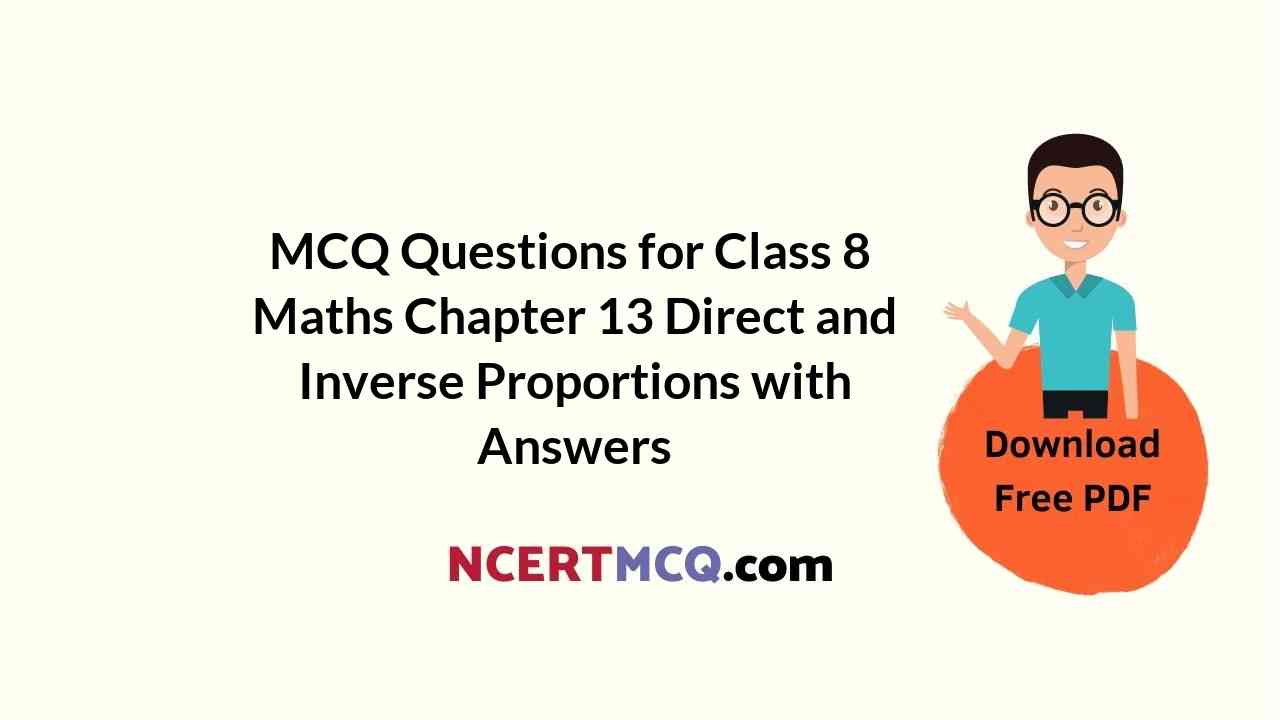
MCQ Questions for Class 8 Maths Chapter 13 Direct and Inverse Proportions with Answers
Check the below Online Education NCERT MCQ Questions for Class 8 Maths Chapter 13 Direct and Inverse Proportions with Answers Pdf free download. MCQ Questions for Class 8 Maths with Answers were prepared based on the latest exam pattern. We have provided Direct and Inverse Proportions Class 8 Maths MCQs Questions with Answers to help students understand the concept very well. https://ncertmcq.com/mcq-questions-for-class-8-maths-with-answers/
Students can also refer to NCERT Solutions for Class 8 Maths Chapter 13 Direct and Indirect Proportions for better exam preparation and score more marks.
Direct and Inverse Proportions Class 8 MCQs Questions with Answers
Direct And Inverse Proportion Class 8 MCQ Question 1.
10 metres of cloth cost Rs 1000. What will 4 metres cost ?
(a) Rs 400
(b) Rs 800
(c) Rs 200
(d) Rs 100.
Answer
Answer: (a) Rs 400
Explanation:
\(\frac{10}{1000}\) = \(\frac{4}{?}\) ⇒ ? = 400
Direct And Inverse Variation Class 8 MCQ Question 2.
15 books weigh 6 kg. What will 6 books weigh ?
(a) 1.2 kg
(b) 2.4 kg
(c) 3.8 kg
(d) 3 kg.
Answer
Answer: (b) 2.4 kg
Explanation:
\(\frac{15}{6}\) = \(\frac{6}{?}\) ⇒ ? = 2.4
MCQ On Direct And Inverse Proportion Class 8 Question 3.
A horse eats 18 kg of com in 12 days ? How much does he eat in 9 days ?
(a) 11.5 kg
(b) 12.5 kg
(c) 13.5 kg
(d) 14.5 kg.
Answer
Answer: (c) 13.5 kg
Explanation:
\(\frac{12}{18}\) = \(\frac{9}{?}\) ⇒ ? = \(\frac{18×9}{12}\) = 13.5
MCQ Questions For Class 8 Maths Direct And Inverse Proportion Question 4.
8 g of sandal wood cost Rs 40. What will 10 g cost ?
(a) Rs 30
(b) Rs 36
(c) Rs 48
(d) Rs 50.
Answer
Answer: (d) Rs 50.
Explanation:
\(\frac{8}{10}\) = \(\frac{10}{?}\) ⇒ ? = 50
Class 8 Direct And Inverse Proportion MCQ Question 5.
20 trucks can hold 150 metric tonnes. How much will 12 trucks hold ?
(a) 80 metric tonnes
(b) 90 metric tonnes
(c) 60 metric tonnes
(d) 40 metric tonnes.
Answer
Answer: (b) 90 metric tonnes
Explanation:
\(\frac{20}{150}\) = \(\frac{12}{?}\) ⇒ ? = 90
Class 8 Maths Chapter 13 MCQ Question 6.
120 copies of a book cost Rs 600. What will 400 copies cost ?
(a) Rs 1000
(b) Rs 2000
(c) Rs 3000
(d) Rs 2400.
Answer
Answer: (b) Rs 2000
Explanation:
\(\frac{120}{600}\) = \(\frac{400}{?}\) ⇒ ? = 2000
Direct And Inverse Proportion MCQ Question 7.
The rent of 7 hectares is Rs 875. What is the rent of 16 hectares ?
(a) Rs 2000
(b) Rs 1500
(c) Rs 1600
(d) Rs 1200.
Answer
Answer: (a) Rs 2000
Explanation:
\(\frac{7}{875}\) = \(\frac{16}{?}\) ⇒ ? = \(\frac{875×16}{7}\) = 2000
Direct And Inverse Proportion MCQ Class 8 Question 8.
A boy runs 1 km in 10 minutes. How long will he take to ran 600 m ?
(a) 2 minutes
(b) 3 minutes
(c) 4 minutes
(d) 6 minutes.
Answer
Answer: (d) 6 minutes.
Explanation:
\(\frac{1000}{10}\) = \(\frac{600}{?}\) ⇒ ? = 6
Class 8 Maths Direct And Inverse Proportion MCQ Question 9.
A shot travels 90 m in 1 second. How long will it take to go 225 m ?
(a) 2 seconds
(b) 2.5 seconds
(c) 4 seconds
(d) 3.5 seconds.
Answer
Answer: (b) 2.5 seconds
Explanation:
\(\frac{90}{1}\) = \(\frac{225}{?}\) ⇒ ? = 2.5
Ch 13 Maths Class 8 MCQ Question 10.
3 knives cost Rs 63. What will 17 knives cost ?
(a) Rs 357
(b) Rs 375
(c) Rs 537
(d) Rs 573.
Answer
Answer: (a) Rs 357
Explanation:
\(\frac{3}{63}\) = \(\frac{17}{?}\) ⇒ ? = 357
MCQ Questions For Class 8 Maths Chapter 13 Question 11.
15 men can mow 40 hectares of land in 1 day. How much will 6 men mow in 1 day ?
(a) 16 hectares
(b) 12 hectares
(c) 20 hectares
(d) 24 hectares.
Answer
Answer: (a) 16 hectares
Explanation:
\(\frac{15}{40}\) = \(\frac{6}{?}\) ⇒ ? = \(\frac{40×6}{15}\) = 16
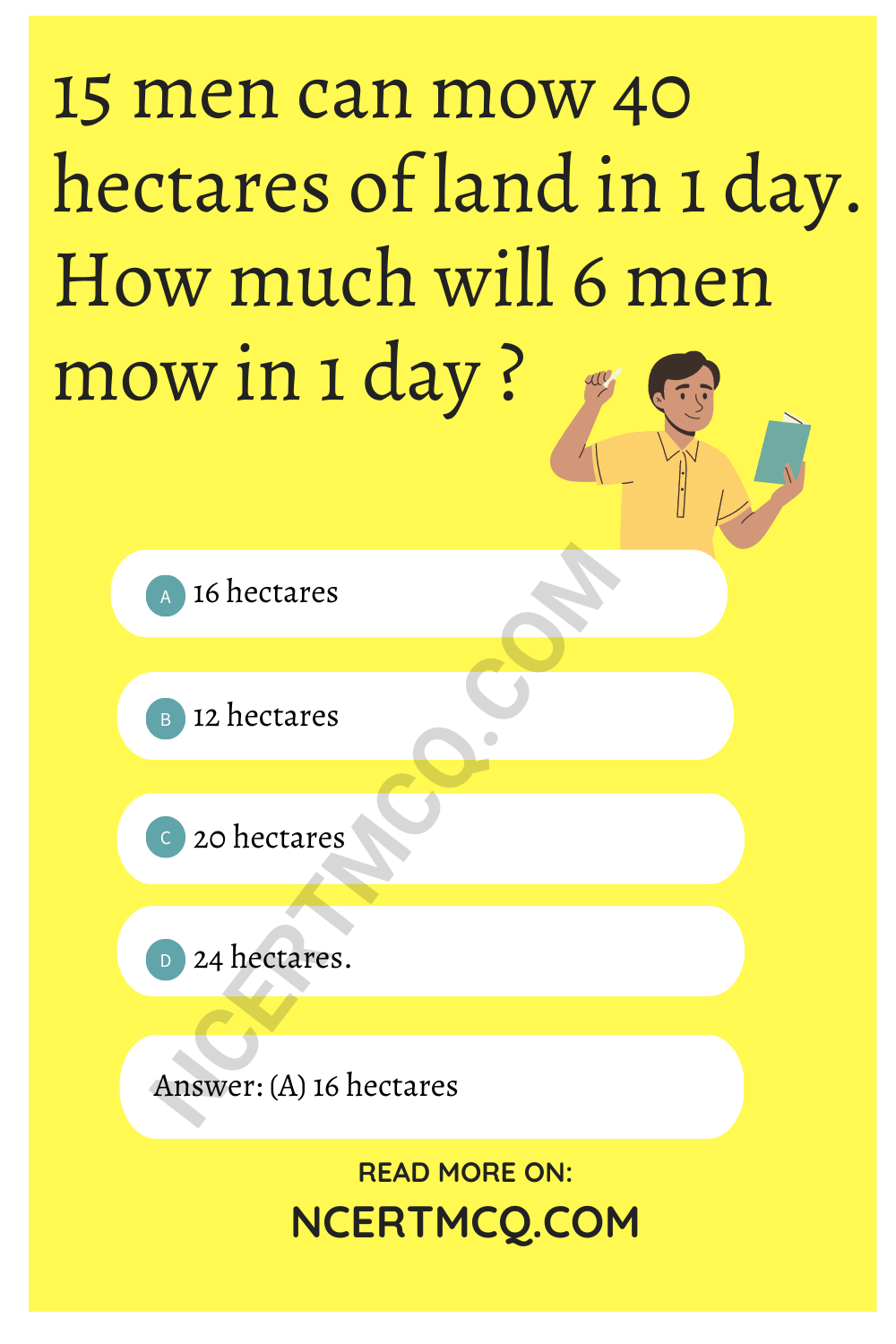
Direct Inverse Proportion Class 8 MCQ Question 12.
A man walks 20 km in 5 hours. How long would he take in walking 32 km ?
(a) 3 hours
(b) 4 hours
(c) 6 hours
(d) 8 hours.
Answer
Answer: (d) 8 hours.
Explanation:
\(\frac{20}{5}\) = \(\frac{32}{?}\) ⇒ ? = 8
MCQ On Direct And Inverse Variation Class 8 Question 13.
What is the cost of 50 sticks at Rs 24 per score ?
(a) Rs 30
(b) Rs 40
(c) Rs 50
(d) Rs 60.
Answer
Answer: (d) Rs 60.
Explanation:
\(\frac{20}{24}\) = \(\frac{50}{?}\) ⇒ ? = 60
Class 8 Maths Ch 13 MCQ Question 14.
A train travels 60 km in 1 hour. How long will it take to go 150 km ?
(a) 2 hours
(b) 3 hours
(c) 2.5 hours
(d) 4 hours.
Answer
Answer: (c) 2.5 hours
Explanation:
\(\frac{60}{1}\) = \(\frac{150}{?}\) ⇒ ? = 2.5
Question 15.
If 3 quintals of coal cost Rs 6000, what is the cost of 120 kg ?
(a) Rs 1200
(b) Rs 2400
(c) Rs 3600
(d) Rs 4800.
Answer
Answer: (b) Rs 2400
Explanation:
\(\frac{300}{6000}\) = \(\frac{120}{?}\) ⇒ ? = 2400
Question 16.
If 20 cows eat as much as 15 oxen, how many cows will eat at much as 36 oxen ?
(a) 40
(b) 44
(c) 45
(d) 48
Answer
Answer: (d) 48
Explanation:
\(\frac{15}{20}\) = \(\frac{36}{?}\) ⇒ ? = \(\frac{20×36}{15}\) = 48
Question 17.
The fare for a journey of 40 km is Rs 25. How much can be travelled for Rs40 ?
(a) 32 km
(b) 64 km
(c) 50 km
(d) 60 km.
Answer
Answer: (b) 64 km
Explanation:
\(\frac{25}{40}\) = \(\frac{40}{?}\) ⇒ ? = \(\frac{40×40}{25}\) = 64
Question 18.
Apala types 200 words in half an hour. How many words will she type in 12 minutes ?
(a) 80
(b) 50
(c) 100
(d) 60.
Answer
Answer: (a) 80
Explanation:
\(\frac{30}{200}\) = \(\frac{12}{?}\) ⇒ ? = 80
Question 19.
A labourer is paid Rs 400 for 2 days work. If he works for 5 days, how much will he get ?
(a) Rs 1000
(b) Rs 800
(c) Rs 750
(d) Rs 900.
Answer
Answer: (a) Rs 1000
Explanation:
\(\frac{2}{400}\) = \(\frac{5}{?}\) ⇒ ? = 1000
Question 20.
A machine in a soft drink factory fills 600 bottles in 5 hours. How many bottles will it fill in 2 hours ?
(a) 120
(b) 180
(c) 150
(d) 240.
Answer
Answer: (d) 240
Explanation:
\(\frac{5}{600}\) = \(\frac{2}{?}\) ⇒ ? = 240
Question 21.
If 8 men can do a piece of work in 20 days, in how many days could 20 men do the same work ?
(a) 6 days
(b) 8 days
(c) 4 days
(d) 10 days.
Answer
Answer: (b) 8 days
Explanation:
8 × 20 = 20 × ? ⇒ ? = 8.
Question 22.
If an amount of food last for 40 days for 120 men, how long will it last for 80 men at the same rate ?
(a) 50 days
(b) 60 days
(c) 80 days
(d) 100 days.
Answer
Answer: (b) 60 days
Explanation:
40 × 120 = 80 × ? ⇒ ? = 60.
Question 23.
If 18 women can reap a field in 7 days, in what time can 6 women reap the same field ?
(a) 15 days
(b) 21 days
(c) 30 days
(d) 36 days.
Answer
Answer: (b) 21 days
Explanation:
18 × 7 = 6 × ? ⇒ ? = 21.
Question 24.
10 men can dig a trench in 15 days. How long will 3 men take ?
(a) 50 days
(b) 60 days
(c) 100 days
(d) 75 days.
Answer
Answer: (a) 50 days
Explanation:
10 × 15 = 3 × ? ⇒ ? = 50.
Question 25.
3 lambs finish eating turnips in 8 days. In how many days will 2 lambs finish them ?
(a) 6
(b) 8
(c) 10
(d) 12.
Answer
Answer: (d) 12
Explanation:
3 × 8 = 2 × ? ⇒ ? = 12.
Question 26.
6 pipes are required to fill a tank in 1 hour. How long will it take if only 5 pipes of the same type are used ?
(a) 75 minutes
(b) 72 minutes
(c) 80 minutes
(d) 90 minutes.
Answer
Answer: (b) 72 minutes
Explanation:
6 × 60 = 5 × ? ⇒ ? = 72 minutes.
Question 27.
40 cows can graze a field in 16 days. How many cows will graze the same field in 10 days ?
(a) 60
(b) 64
(c) 80
(d) 75.
Answer
Answer: (b) 64
Explanation:
40 × 16 = ? × 10 ⇒ ? = 64.
Question 28.
If x = ky and when y = 4, x = 8 then k =
(a) 1
(b) 2
(c) 3
(d) 4.
Answer
Answer: (b) 2
Explanation:
8 = 4k ⇒ k = 2.
Question 29.
The constant of variation, if x ∝ y, from the following table is
![]()
(a ) 1
(b) 2
(c) 3
(d) 4.
Answer
Answer: (c) 3
Explanation:
2 × 3 = 6, 4 × 3 = 12,
5 × 3 = 15, 7 × 3 = 21.
Question 30.
x and y vary inversely with each other. If x – 15 when y = 6, then the value of x when y = 15 is
(a) 2
(b) 4
(c) 5
(d) 6.
Answer
Answer: (d) 6
Explanation:
15 × 6 = ? × 15 ⇒ ? = 6.
Question 31.
If x = 20 and y = 40, then x and y are:
(a) Directly proportional
(b) Inversely proportional
(c) Neither directly nor inversely proportional
(d) Cannot be determined
Answer
Answer: (a) Directly proportional
Explanation:
x = 20 and y = 40
Clearly, 40 = 2 × 20
y = 2x
y ∝ x, where 2 is the proportionality constant.
Question 32.
If x = 15 and y = 1/30, then x and y are:
(a) Directly proportional
(b) Inversely proportional
(c) Neither directly nor inversely proportional
(d) Cannot be determined
Answer
Answer: (a) Directly proportional
Explanation:
x = 15, y = 1/30
1/30 = 1/(2 × 15)
y = 1/2x
Hence, y ∝ 1/x, where 1/2 is the proportionality constant.
Question 33.
If x and y are directly proportional, then which of the following is correct?
(a) x + y = constant
(b) x – y = constant
(c) xy = constant
(d) x/y = constant
Answer
Answer: (d) x/y = constant
Explanation:
x ∝ y
x = ky
k = x/y, where k is a constant.
Question 34.
If x and y are inversely proportional, then:
(a) x + y = constant
(b) x – y = constant
(c) xy = constant
(d) x/y = constant
Answer
Answer: (c) xy = constant
Explanation:
x ∝ 1/y
x = k/y
xy = k
Where k is a constant.
Question 35.
If x ∝ y and x1= 5, y1 = 210 and x2 = 2, then find y2 ?
(a) 200
(b) 84
(c) 99
(d) 70
Answer
Answer: (b) 84
Explanation:
x ∝ y
x = ky
x/y = k
x1/y1 = x2/y2
5/210 = 2/y2
y2 = 84
Question 36.
If the weight of 12 sheets of thick paper is 40 grams, how many sheets of the same paper would weigh 2500 grams?
(a) 750
(b) 800
(c) 850
(d) 950
Answer
Answer: (a) 750
Explanation:
For 12 sheets, weight of paper is 40 grams
Let number of sheets for 2500 is x.
Using direct proportion concept:
12/40 = x/2500
x = (12 × 2500)/40
x = 750
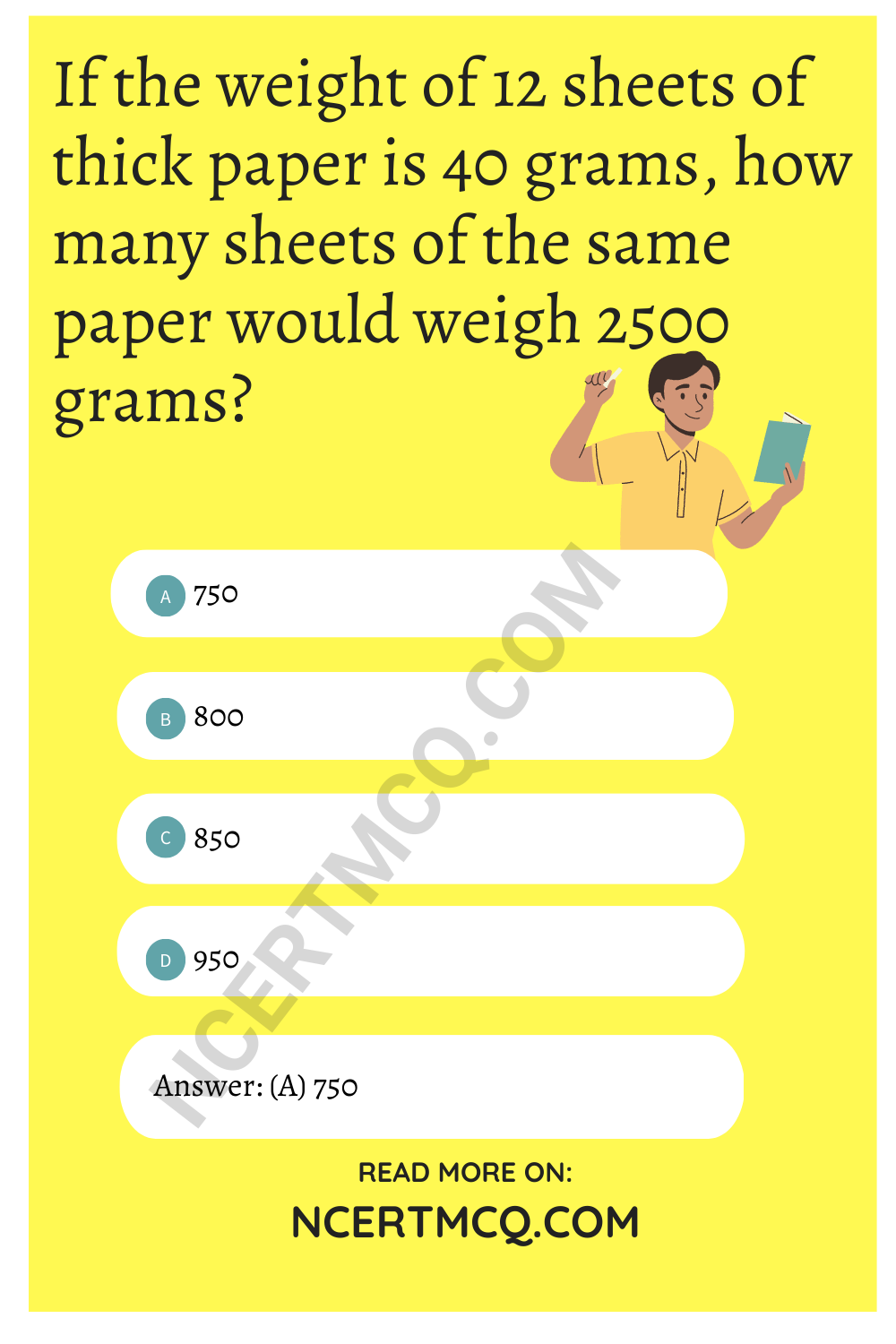
Question 37.
The scale of a map is given as 1 : 300. Two cities are 4 km apart on the map. The actual distance between them is:
(a) 1000 km
(b) 1100 km
(c) 1200 km
(d) 1300 km
Answer
Answer: (c) 1200 km
Explanation:
1 : 300 = x : y
1/300 = 4/y
y = 4 x 300 = 1200
Hence, the distance between the two cities is 1200 km.
Question 38.
If x and y are inversely proportional, then which one is true?
(a) x1/y1 = x2/y2
(b) x1/x2 = y1/y2
(c) x1/x2 = y2/y1
(d) x1.x2 = y1.y2
Answer
Answer: (c) x1/x2 = y2/y1
Explanation:
x ∝1/y
x = k (1/y)
xy = k
x1y1=x2y2
x1/x2=y2/y1
Question 39.
6 pipes are required to fill a tank in 1 hour 20 minutes. If we use 5 such types of pipes, how much time it will take to fill the tank?
(a) 120 minutes
(b) 96 minutes
(c) 80 minutes
(d) 85 minutes
Answer
Answer: (b) 96 minutes
Explanation:
For 6 pipes, it takes 1 hour 20 minutes
1 hour 20 minutes = 60 + 20 = 80 minutes
For 5 pipes, let the time taken be x.
This is inverse proportion case:
80 × 6 = x × 5
x = 480/5 = 96
Question 40.
If 12 workers can build a wall in 50 hours, how many workers will be required to do the same work in 40 hours?
(a) 10
(b) 13
(c) 14
(d) 15
Answer
Answer: (d) 15
Explanation:
12 × 50 = x × 40
x = (12×50)/40 = 15
We hope the given NCERT MCQ Questions for Class 8 Maths Chapter 13 Direct and Inverse Proportions with Answers Pdf free download will help you. If you have any queries regarding Direct and Inverse Proportions CBSE Class 8 Maths MCQs Multiple Choice Questions with Answers, drop a comment below and we will get back to you soon.
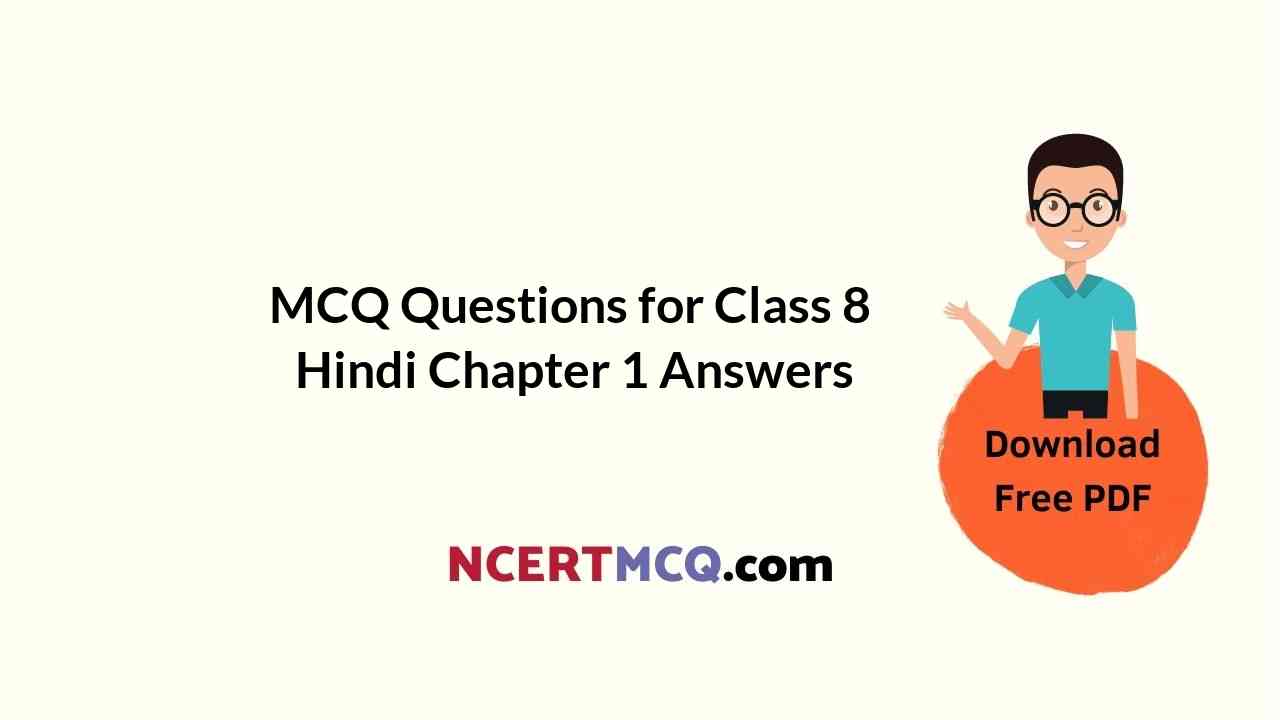
MCQ Questions for Class 8 Hindi Chapter 1 ध्वनि with Answers
Check the below NCERT MCQ Questions for Class 8 Hindi Vasant Chapter 1 ध्वनि with Answers Pdf free download. MCQ Questions for Class 8 Hindi with Answers were prepared based on the latest exam pattern. We have provided ध्वनि Class 8 Hindi MCQs Questions with Answers to help students understand the concept very well. https://ncertmcq.com/mcq-questions-for-class-8-hindi-with-answers/
Students can also read NCERT Solutions for Class 8 Hindi Chapter 1 Questions and Answers at LearnInsta. Here all questions are solved with a detailed explanation, It will help to score more marks in your examinations.
ध्वनि Class 8 MCQs Questions with Answers
Class 8 Hindi Chapter 1 MCQ Question 1.
‘ध्वनि’ कविता के रचयिता निम्नलिखित में से कौन हैं?
(a) रामधारी सिंह ‘दिनकर’
(b) सूर्यकांत त्रिपाठी ‘निराला’
(c) रामचंद्र तिवारी
(d) प्रभुनारायण
Answer
Answer: (b) सूर्यकांत त्रिपाठी ‘निराला’
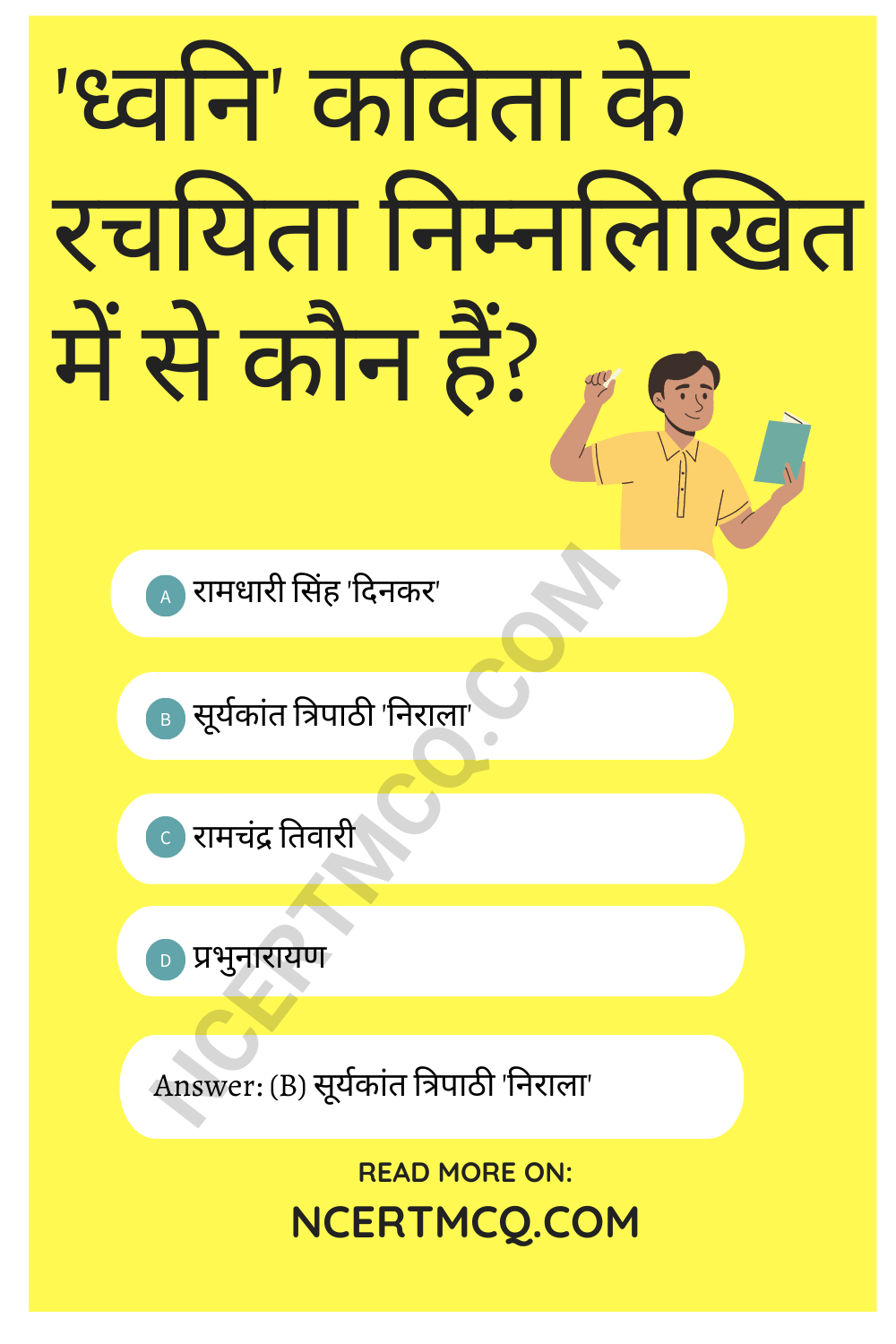
Class 8 Hindi Ch 1 MCQ Question 2.
इस काव्यांश की कविता का नाम है-
(a) वसंत
(b) ध्वनि
(c) सवेरा
(d) मनोहर
Answer
Answer: (b) ध्वनि
MCQ Questions For Class 8 Hindi Chapter 1 Question 3.
अभी किसका अंत न होगा?
(a) वसंत का
(b) कवि के जीवन का
(c) प्रभाव का
(d) कलियों का
Answer
Answer: (b) कवि के जीवन का
Hindi Class 8 Chapter 1 MCQ Question 4.
कवि पुष्य-पुष्प से क्या खींच लेना चाहता है?
(a) मिठास
(b) पराग
(c) खुशबू
(d) तंद्रालस लालसा
Answer
Answer: (d) तंद्रालस लालसा
Ncert Class 8 Hindi Chapter 1 MCQ Question 5.
‘कलियाँ’ किसका प्रतीक हैं?
(a) नवयुवकों का
(b) फूलों का
(c) वसंत का
(d) प्रातः काल का
Answer
Answer: (a) नवयुवकों का
Class 8 Chapter 1 Hindi MCQ Question 6.
‘कलियाँ कोमल’ में किस अलंकार का प्रयोग हुआ है?
(a) अनुप्रास
(b) पुनरुक्ति का
(c) यमक
(d) श्लेष
Answer
Answer: (a) अनुप्रास
Ch 1 Hindi Class 8 MCQ Question 7.
कवि पुष्यों को सहर्ष किससे सींचना चाहता है?
(a) नवजीवन के अमृत से
(b) नवजीवन के जल से
(c) नवजीवन की वर्षा से
(d) इनमें से कोई नहीं
Answer
Answer: (a) नवजीवन के अमृत से
Hindi Chapter 1 Class 8 MCQ Question 8.
कवि खिले फूलों को कहाँ का द्वार दिखाना चाहता है?
(a) उपवन का
(b) विद्यालय का
(c) अनंत का
(d) उद्यान का
Answer
Answer: (c) अनंत का
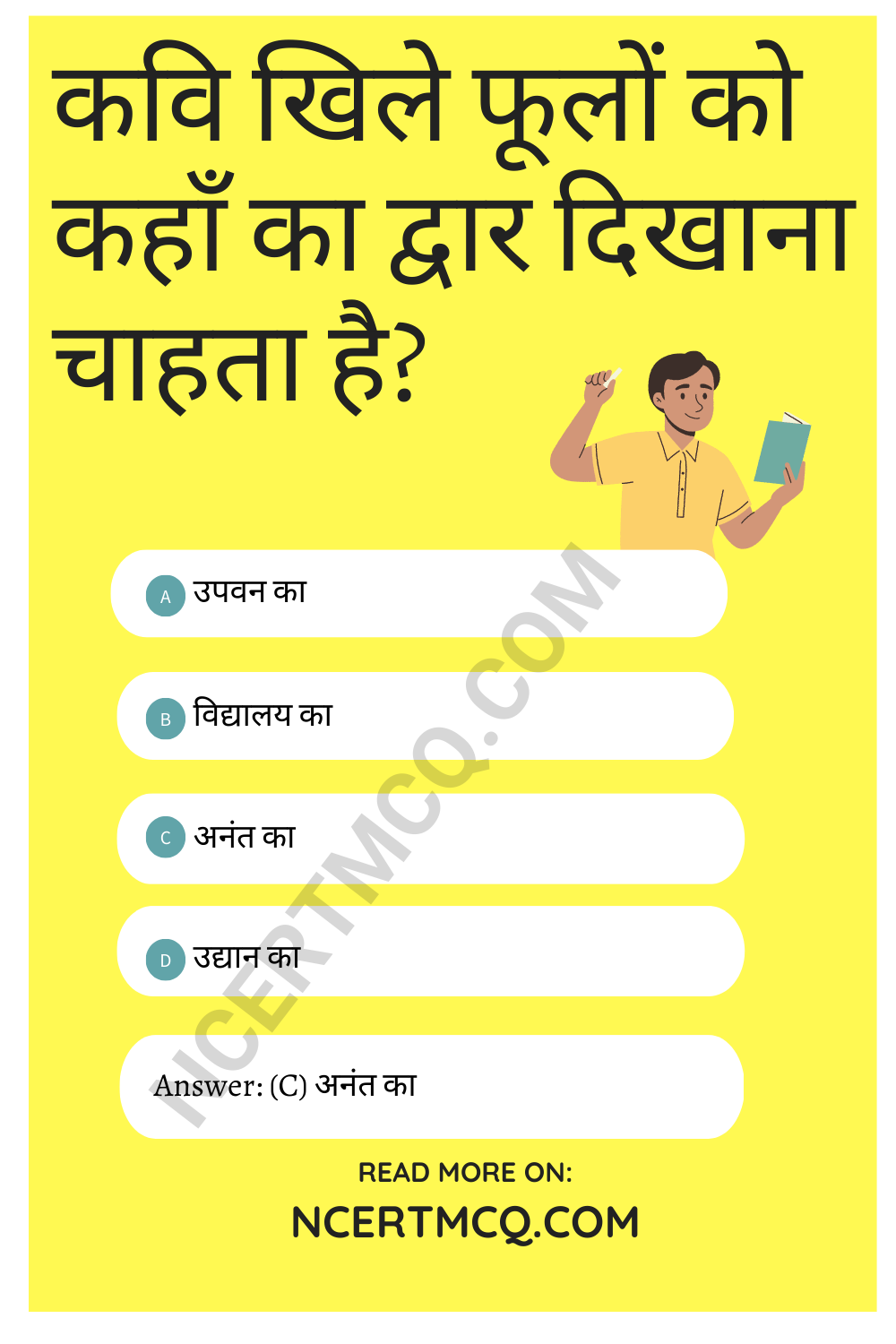
(1)
अभी न होगा मेरा अंत
अभी-अभी ही तो आया है
मेरे वन में मृदुल वसंत-
अभी न होगा मेरा अंत।
हरे-हरे ये पात,
डालियाँ, कलियाँ, कोमल गात।
मैं ही अपना स्वप्न-मृदुल-कर
फेरूँगा निद्रित कलियों पर
जगा एक प्रत्यूष मनोहर।
Chapter 1 Hindi Class 8 MCQ Question 1.
कवि और कविता का नाम लिखिए।
Answer
Answer:
कवि का नाम-सूर्यकांत त्रिपाठी ‘निराला’
कविता का नाम-‘ध्वनि’।
Class 8 Hindi MCQ Chapter 1 Question 2.
‘अभी न होगा मेरा अंत’ कवि ने ऐसा क्यों कहा?
Answer
Answer: ‘अभी न होगा मेरा अंत’ कवि ने ऐसा इसलिए कहा है, क्योंकि वे बताना चाहते हैं कि अभी अंत नहीं होने वाला है। अभी अभी तो वसंत का आगमन हुआ है जिससे उसका जीवन खुशियों से भर गया है। वह उमंग से भरा हुआ है।
Class 8th Hindi Chapter 1 MCQ Question 3.
‘वन में मृदुल वसंत’ पंक्ति से आशय क्या है?
Answer
Answer: वन में मृदुल वसंत का अभिप्राय है- वन रूपी जीवन में वसंत का आगमन होना है।
Class 8 Ch 1 Hindi MCQ Question 4.
कवि पर वसंत का क्या प्रभाव दिखाई देता है?
Answer
Answer: वसंत के आगमन पर पेड़ों पर नए-नए, हरे-हरे पत्ते निकल आते हैं। नई-नई डालियाँ निकल आती हैं जिन पर कोमल कलियाँ निकल आती हैं जिससे कवि का जीवन खुशियों से भर गया है। कवि उमंग से भरा हुआ है।
MCQ Questions For Class 8 Hindi Chapter 1 With Answers Question 5.
वसंत का क्या प्रभाव दिखाई देता है ?
Answer
Answer: वन कवि के जीवन रूपी उपवन का और निद्रित कलियाँ-आलस्य में डूबे हुए नवयुवकों का प्रतीक है।
(2)
पुष्प-पुष्प से तंद्रालस लालसा खींच लूँगा मैं,
अपने नव जीवन का अमृत सहर्ष सींच दूंगा मैं,
द्वार दिखा दूंगा फिर उनको।
हैं मेरे वे जहाँ अनंत-
अभी न होगा मेरा अंत।
Question 1.
कवि एवं कविता का नाम लिखिए।
Answer
Answer:
कवि का नाम- सूर्यकांत त्रिपाठी ‘निराला’
कविता का नाम-ध्वनि।
Question 2.
कवि पुष्पों को किस रूप में देखता है और इनमें क्या परिवर्तन चाहता है?
Answer
Answer: कवि को पुष्प आलसी तथा नींद से बोझिल दिखाए पड़ रहे हैं। अपने स्पर्श से पुष्पों की नींद भरी आँखों से आलस्य छीन लेना चाहता है, यानी कवि उनका आलस्य दूर कर उन्हें चुस्त और जागरूक बनाना चाहता है।
Question 3.
कवि पुष्पों को अनंत का द्वार दिखाना चाहता हैं, क्यों?
Answer
Answer: कवि पुष्पों को अनंत का द्वार इसलिए दिखाना चाहता है क्योंकि फूल खिलकर अनंत काल तक अपनी महक एवं सौंदर्य बिखेरते रहें। जीवन में आशा एवं उत्साह से भरपूर रहें। उनका जीवन फूलों के समान महक उठे।
Question 4.
कवि की चाहत क्या है?
Answer
Answer: कवि की चाहत है कि वह पुष्प के जीवन के आलस्य, निराशा व प्रमाद को दूर करना चाहता है। वह अपने अनंत से सप्राण भेंट करना चाहता है। वह अपने जीवन की आभा, सुषमा व कर्तव्य भावना को यशस्वी बनाकर चारों ओर फैलाना चाहता है।
We hope the given NCERT MCQ Questions for Class 8 Hindi Vasant Chapter 1 ध्वनि with Answers Pdf free download will help you. If you have any queries regarding CBSE Class 8 Hindi ध्वनि MCQs Multiple Choice Questions with Answers, drop a comment below and we will get back to you soon.